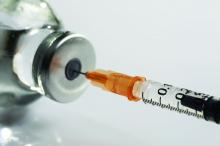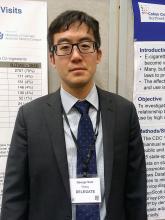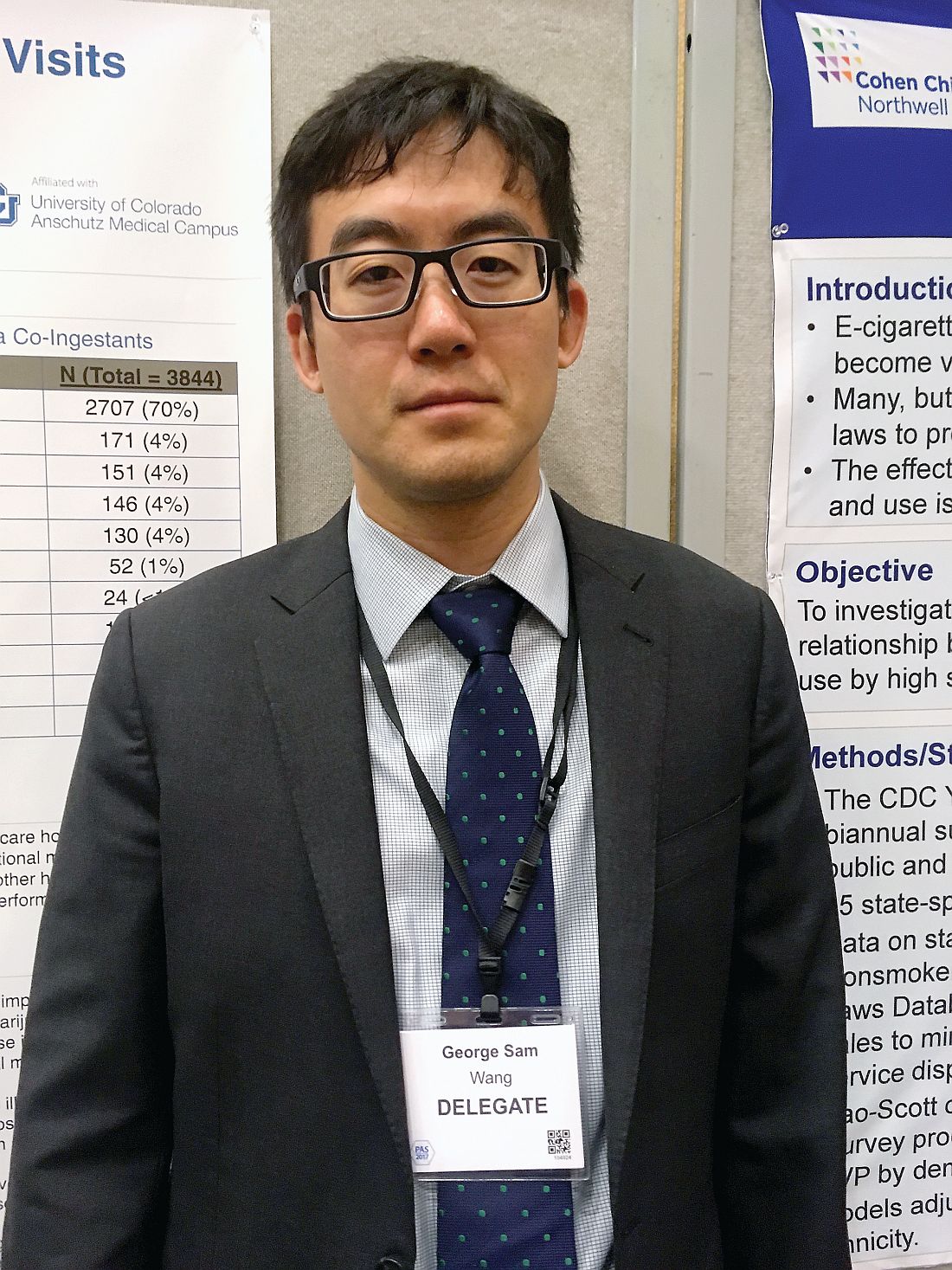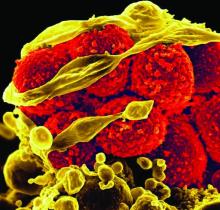User login
GI disorders more prevalent in children with poorly controlled asthma
SAN FRANCISCO – Pediatric patients who have asthma that is poorly controlled may be more likely to have functional gastrointestinal (GI) disorders, which feature chronic GI distress that has several causes, according to a study of patients treated at one hospital.
Female sex and increased anxiety were influential factors.
“This study suggests a high prevalence of functional GI disorders among patients with persistent asthma. Moreover, patients with functional GI disorders had poor asthma control and increased anxiety. Clinicians should consider functional GI disorders in patients with poor asthma control and assess for anxiety as indicated,” Ruben J. Colman, MD, a pediatric resident at SBH Health System, Bronx, N.Y., said at the Pediatric Academic Societies meeting.
Functional GI disorders including functional abdominal pain, irritable bowel syndrome, and functional dyspepsia were evaluated. The study was prompted by the knowledge that these conditions are a common cause of chronic GI symptoms in children, and from the findings of a retrospective study of 30,000 patients in Europe that reported a higher prevalence of asthma in those with functional GI disorders, compared with those without chronic GI distress (Aliment Pharmacol Ther. 2014 Aug;40[40]:382-91). Data are scarce in North America concerning asthma control and functional GI disorders in both pediatric and adult populations.
The validated Questionnaire on Pediatric Gastrointestinal Symptoms–Rome III version was used to assess functional GI disorders. Asthma control was assessed using the childhood Asthma Control Test (ACT) questionnaire, with scores exceeding 30, less than 19, and less than 14 indicating well-controlled, not well-controlled, and poorly controlled asthma, respectively. Anxiety was assessed using the Beck Anxiety Inventory, with increasing scores indicating increasing anxiety.
The 110 enrolled patients had a mean age of 10 years. Age was similar between the 18 patients with functional GI disorders – representing a prevalence rate of 16% – and the 92 without such disorders at 12 and 10 years, respectively. Those with functional GI disorders were predominantly female, compared with the patients without a functional GI disorder (72% vs 45%; P less than .03). The GI distress in the 18 patients comprised 10 cases of abdominal pain disorders and 13 cases of upper GI tract disorders, with 3 patients having an overlap of 2 to 3 functional GI disorders.
Patients with functional GI disorders had a lower mean ACT score, compared with those without (12 vs. 15; P = .03). Functional GI disorders also were associated with higher anxiety scores (34 vs. 14; P less than .01).
Asthma control significantly predicted the presence of functional GI disorders in univariate analysis (odds ratio, 0.9; 95% confidence interval, 0.80-0.99; P = .03). However, this significance was lost in a multivariate analysis that adjusted for asthma control, anxiety, and sex. The multivariate analysis revealed continued significant associations between functional GI disorders and anxiety (OR, 1.1; 95% CI, 1.01-1.10; P less than .01) and female sex (OR, 3.3; 95% CI, 1.00-10.56; P less than .05).
Dr. Colman speculated that the apparent association of asthma with chronic GI distress could reflect asthma-related inflammation that exacerbates the GI disorders. Future research should examine if improving the control of asthma and lessening anxiety can decrease symptoms of functional GI disorders.
SAN FRANCISCO – Pediatric patients who have asthma that is poorly controlled may be more likely to have functional gastrointestinal (GI) disorders, which feature chronic GI distress that has several causes, according to a study of patients treated at one hospital.
Female sex and increased anxiety were influential factors.
“This study suggests a high prevalence of functional GI disorders among patients with persistent asthma. Moreover, patients with functional GI disorders had poor asthma control and increased anxiety. Clinicians should consider functional GI disorders in patients with poor asthma control and assess for anxiety as indicated,” Ruben J. Colman, MD, a pediatric resident at SBH Health System, Bronx, N.Y., said at the Pediatric Academic Societies meeting.
Functional GI disorders including functional abdominal pain, irritable bowel syndrome, and functional dyspepsia were evaluated. The study was prompted by the knowledge that these conditions are a common cause of chronic GI symptoms in children, and from the findings of a retrospective study of 30,000 patients in Europe that reported a higher prevalence of asthma in those with functional GI disorders, compared with those without chronic GI distress (Aliment Pharmacol Ther. 2014 Aug;40[40]:382-91). Data are scarce in North America concerning asthma control and functional GI disorders in both pediatric and adult populations.
The validated Questionnaire on Pediatric Gastrointestinal Symptoms–Rome III version was used to assess functional GI disorders. Asthma control was assessed using the childhood Asthma Control Test (ACT) questionnaire, with scores exceeding 30, less than 19, and less than 14 indicating well-controlled, not well-controlled, and poorly controlled asthma, respectively. Anxiety was assessed using the Beck Anxiety Inventory, with increasing scores indicating increasing anxiety.
The 110 enrolled patients had a mean age of 10 years. Age was similar between the 18 patients with functional GI disorders – representing a prevalence rate of 16% – and the 92 without such disorders at 12 and 10 years, respectively. Those with functional GI disorders were predominantly female, compared with the patients without a functional GI disorder (72% vs 45%; P less than .03). The GI distress in the 18 patients comprised 10 cases of abdominal pain disorders and 13 cases of upper GI tract disorders, with 3 patients having an overlap of 2 to 3 functional GI disorders.
Patients with functional GI disorders had a lower mean ACT score, compared with those without (12 vs. 15; P = .03). Functional GI disorders also were associated with higher anxiety scores (34 vs. 14; P less than .01).
Asthma control significantly predicted the presence of functional GI disorders in univariate analysis (odds ratio, 0.9; 95% confidence interval, 0.80-0.99; P = .03). However, this significance was lost in a multivariate analysis that adjusted for asthma control, anxiety, and sex. The multivariate analysis revealed continued significant associations between functional GI disorders and anxiety (OR, 1.1; 95% CI, 1.01-1.10; P less than .01) and female sex (OR, 3.3; 95% CI, 1.00-10.56; P less than .05).
Dr. Colman speculated that the apparent association of asthma with chronic GI distress could reflect asthma-related inflammation that exacerbates the GI disorders. Future research should examine if improving the control of asthma and lessening anxiety can decrease symptoms of functional GI disorders.
SAN FRANCISCO – Pediatric patients who have asthma that is poorly controlled may be more likely to have functional gastrointestinal (GI) disorders, which feature chronic GI distress that has several causes, according to a study of patients treated at one hospital.
Female sex and increased anxiety were influential factors.
“This study suggests a high prevalence of functional GI disorders among patients with persistent asthma. Moreover, patients with functional GI disorders had poor asthma control and increased anxiety. Clinicians should consider functional GI disorders in patients with poor asthma control and assess for anxiety as indicated,” Ruben J. Colman, MD, a pediatric resident at SBH Health System, Bronx, N.Y., said at the Pediatric Academic Societies meeting.
Functional GI disorders including functional abdominal pain, irritable bowel syndrome, and functional dyspepsia were evaluated. The study was prompted by the knowledge that these conditions are a common cause of chronic GI symptoms in children, and from the findings of a retrospective study of 30,000 patients in Europe that reported a higher prevalence of asthma in those with functional GI disorders, compared with those without chronic GI distress (Aliment Pharmacol Ther. 2014 Aug;40[40]:382-91). Data are scarce in North America concerning asthma control and functional GI disorders in both pediatric and adult populations.
The validated Questionnaire on Pediatric Gastrointestinal Symptoms–Rome III version was used to assess functional GI disorders. Asthma control was assessed using the childhood Asthma Control Test (ACT) questionnaire, with scores exceeding 30, less than 19, and less than 14 indicating well-controlled, not well-controlled, and poorly controlled asthma, respectively. Anxiety was assessed using the Beck Anxiety Inventory, with increasing scores indicating increasing anxiety.
The 110 enrolled patients had a mean age of 10 years. Age was similar between the 18 patients with functional GI disorders – representing a prevalence rate of 16% – and the 92 without such disorders at 12 and 10 years, respectively. Those with functional GI disorders were predominantly female, compared with the patients without a functional GI disorder (72% vs 45%; P less than .03). The GI distress in the 18 patients comprised 10 cases of abdominal pain disorders and 13 cases of upper GI tract disorders, with 3 patients having an overlap of 2 to 3 functional GI disorders.
Patients with functional GI disorders had a lower mean ACT score, compared with those without (12 vs. 15; P = .03). Functional GI disorders also were associated with higher anxiety scores (34 vs. 14; P less than .01).
Asthma control significantly predicted the presence of functional GI disorders in univariate analysis (odds ratio, 0.9; 95% confidence interval, 0.80-0.99; P = .03). However, this significance was lost in a multivariate analysis that adjusted for asthma control, anxiety, and sex. The multivariate analysis revealed continued significant associations between functional GI disorders and anxiety (OR, 1.1; 95% CI, 1.01-1.10; P less than .01) and female sex (OR, 3.3; 95% CI, 1.00-10.56; P less than .05).
Dr. Colman speculated that the apparent association of asthma with chronic GI distress could reflect asthma-related inflammation that exacerbates the GI disorders. Future research should examine if improving the control of asthma and lessening anxiety can decrease symptoms of functional GI disorders.
AT PAS 17
Key clinical point: The prevalence of functional gastrointestinal disorders is high in pediatric patients with poorly controlled asthma.
Major finding:
Data source: Prospective cross-sectional study at one institution.
Disclosures: The sponsor of the study was SBH Health System. The study was not funded. Dr. Colman had no conflicts to report.
State e-cigarette laws linked to reduced youth use
Several state regulations governing the sales or use of e-cigarettes and related products were associated with lower proportions of youth trying or regularly using vaping products, a new study found.
Restricting sales of electronic vapor products to minors, however, was not linked to a lower risk of vaping among teens.
Dr. Keim and her associates investigated possible associations between various state laws related to vaping products, all passed before 2015, and youth use of the products. They relied on 2015 data from 35 state-specific surveys of youth regarding use of vaping products and from the Youth Risk Behavior Survey from the Centers for Disease Control and Prevention, a nationally representative, biannual survey of students in grades 9-12. The Tobacco Control Laws Database of the American Nonsmokers’ Rights Foundation provided information on state laws related to electronic vapor products.
Among the 200,513 teens whose responses were included in the study, 44% had ever used any kind of electronic vapor product. Rates were similar between girls and boys for ever having tried one or currently using one, Dr. Keim reported at the Pediatric Academic Societies annual meeting.
The researchers looked at associations with each of the following types of laws:
• Statewide prohibition of vaping products on school property or in workplaces, which includes Arizona, New Hampshire, Vermont, and Virginia for schools and North Dakota for workplaces.
• Prohibition of sales to minors under age 18 years, present in 24 states.
• Prohibition or restriction of sales of e-cigarette products from vending machines, present in 17 states.
• Prohibition or restriction of self-service displays of vaping products, present in 11 states.
• Prohibition or restriction of sampling of electronic vapor products, present in Arizona, Delaware, Kentucky, Maryland, New Hampshire, North Carolina, Oklahoma, and South Carolina.
For most of the regulations, teens had a reduced likelihood of trying or currently using vaping products after adjusting for age, ethnicity, grade level, race, region, and sex. Risk of ever trying a vaping product was 12% lower in states that prohibited their use on school grounds or in workplaces, 6% lower in states that barred sales to those under age 18, and 7% lower in states that restricted or prohibited self-service vaping displays.
The risk of youth currently using electronic vapor products was 5% lower in states with the school grounds and workplace restrictions, and 13% lower in states that restricted self-service displays. Laws restricting minor sales were unrelated to the risk of current vaping among youth. Restricting vending machine sales of vaping products had no association with the risk of a teen ever trying vaping, but it was linked to a 7% lower risk of current use of the products among teens. All these associations were statistically significant based on confidence interval values.
Interestingly, a statistically significant risk increase in vaping use occurred for teens in states that restricted or outlawed sampling of vaping products. The risk was 8% higher for ever trying a product and 20% higher for current use. But those findings also could indicate the possibility of reverse causation.
“It’s possible that states that were particularly concerned about sampling had the worst problems – were the ones more likely to institute a ban on that practice, and that would generate the counterintuitive finding,” Dr. Keim said in an interview. “With the data currently available, we can’t look at teen use both before and after the restrictions, just afterwards, but with more data for 2017, it would provide a clearer picture of all of the associations we examined.”
Aside from these laws, other interventions have the potential to reduce vaping among teens as well.
“Restrictions on use in various types of public places and on school grounds may be additional helpful approaches, similar to what has been done with cigarettes,” Dr. Keim said. Although their analysis included laws that prohibited use on school grounds, only four states have one of these laws.
Several state regulations governing the sales or use of e-cigarettes and related products were associated with lower proportions of youth trying or regularly using vaping products, a new study found.
Restricting sales of electronic vapor products to minors, however, was not linked to a lower risk of vaping among teens.
Dr. Keim and her associates investigated possible associations between various state laws related to vaping products, all passed before 2015, and youth use of the products. They relied on 2015 data from 35 state-specific surveys of youth regarding use of vaping products and from the Youth Risk Behavior Survey from the Centers for Disease Control and Prevention, a nationally representative, biannual survey of students in grades 9-12. The Tobacco Control Laws Database of the American Nonsmokers’ Rights Foundation provided information on state laws related to electronic vapor products.
Among the 200,513 teens whose responses were included in the study, 44% had ever used any kind of electronic vapor product. Rates were similar between girls and boys for ever having tried one or currently using one, Dr. Keim reported at the Pediatric Academic Societies annual meeting.
The researchers looked at associations with each of the following types of laws:
• Statewide prohibition of vaping products on school property or in workplaces, which includes Arizona, New Hampshire, Vermont, and Virginia for schools and North Dakota for workplaces.
• Prohibition of sales to minors under age 18 years, present in 24 states.
• Prohibition or restriction of sales of e-cigarette products from vending machines, present in 17 states.
• Prohibition or restriction of self-service displays of vaping products, present in 11 states.
• Prohibition or restriction of sampling of electronic vapor products, present in Arizona, Delaware, Kentucky, Maryland, New Hampshire, North Carolina, Oklahoma, and South Carolina.
For most of the regulations, teens had a reduced likelihood of trying or currently using vaping products after adjusting for age, ethnicity, grade level, race, region, and sex. Risk of ever trying a vaping product was 12% lower in states that prohibited their use on school grounds or in workplaces, 6% lower in states that barred sales to those under age 18, and 7% lower in states that restricted or prohibited self-service vaping displays.
The risk of youth currently using electronic vapor products was 5% lower in states with the school grounds and workplace restrictions, and 13% lower in states that restricted self-service displays. Laws restricting minor sales were unrelated to the risk of current vaping among youth. Restricting vending machine sales of vaping products had no association with the risk of a teen ever trying vaping, but it was linked to a 7% lower risk of current use of the products among teens. All these associations were statistically significant based on confidence interval values.
Interestingly, a statistically significant risk increase in vaping use occurred for teens in states that restricted or outlawed sampling of vaping products. The risk was 8% higher for ever trying a product and 20% higher for current use. But those findings also could indicate the possibility of reverse causation.
“It’s possible that states that were particularly concerned about sampling had the worst problems – were the ones more likely to institute a ban on that practice, and that would generate the counterintuitive finding,” Dr. Keim said in an interview. “With the data currently available, we can’t look at teen use both before and after the restrictions, just afterwards, but with more data for 2017, it would provide a clearer picture of all of the associations we examined.”
Aside from these laws, other interventions have the potential to reduce vaping among teens as well.
“Restrictions on use in various types of public places and on school grounds may be additional helpful approaches, similar to what has been done with cigarettes,” Dr. Keim said. Although their analysis included laws that prohibited use on school grounds, only four states have one of these laws.
Several state regulations governing the sales or use of e-cigarettes and related products were associated with lower proportions of youth trying or regularly using vaping products, a new study found.
Restricting sales of electronic vapor products to minors, however, was not linked to a lower risk of vaping among teens.
Dr. Keim and her associates investigated possible associations between various state laws related to vaping products, all passed before 2015, and youth use of the products. They relied on 2015 data from 35 state-specific surveys of youth regarding use of vaping products and from the Youth Risk Behavior Survey from the Centers for Disease Control and Prevention, a nationally representative, biannual survey of students in grades 9-12. The Tobacco Control Laws Database of the American Nonsmokers’ Rights Foundation provided information on state laws related to electronic vapor products.
Among the 200,513 teens whose responses were included in the study, 44% had ever used any kind of electronic vapor product. Rates were similar between girls and boys for ever having tried one or currently using one, Dr. Keim reported at the Pediatric Academic Societies annual meeting.
The researchers looked at associations with each of the following types of laws:
• Statewide prohibition of vaping products on school property or in workplaces, which includes Arizona, New Hampshire, Vermont, and Virginia for schools and North Dakota for workplaces.
• Prohibition of sales to minors under age 18 years, present in 24 states.
• Prohibition or restriction of sales of e-cigarette products from vending machines, present in 17 states.
• Prohibition or restriction of self-service displays of vaping products, present in 11 states.
• Prohibition or restriction of sampling of electronic vapor products, present in Arizona, Delaware, Kentucky, Maryland, New Hampshire, North Carolina, Oklahoma, and South Carolina.
For most of the regulations, teens had a reduced likelihood of trying or currently using vaping products after adjusting for age, ethnicity, grade level, race, region, and sex. Risk of ever trying a vaping product was 12% lower in states that prohibited their use on school grounds or in workplaces, 6% lower in states that barred sales to those under age 18, and 7% lower in states that restricted or prohibited self-service vaping displays.
The risk of youth currently using electronic vapor products was 5% lower in states with the school grounds and workplace restrictions, and 13% lower in states that restricted self-service displays. Laws restricting minor sales were unrelated to the risk of current vaping among youth. Restricting vending machine sales of vaping products had no association with the risk of a teen ever trying vaping, but it was linked to a 7% lower risk of current use of the products among teens. All these associations were statistically significant based on confidence interval values.
Interestingly, a statistically significant risk increase in vaping use occurred for teens in states that restricted or outlawed sampling of vaping products. The risk was 8% higher for ever trying a product and 20% higher for current use. But those findings also could indicate the possibility of reverse causation.
“It’s possible that states that were particularly concerned about sampling had the worst problems – were the ones more likely to institute a ban on that practice, and that would generate the counterintuitive finding,” Dr. Keim said in an interview. “With the data currently available, we can’t look at teen use both before and after the restrictions, just afterwards, but with more data for 2017, it would provide a clearer picture of all of the associations we examined.”
Aside from these laws, other interventions have the potential to reduce vaping among teens as well.
“Restrictions on use in various types of public places and on school grounds may be additional helpful approaches, similar to what has been done with cigarettes,” Dr. Keim said. Although their analysis included laws that prohibited use on school grounds, only four states have one of these laws.
FROM PAS 2017
Key clinical point: The two state laws associated with lower risks of teens trying or currently using e-cigarette products were prohibiting their use at school or work and prohibiting or restricting self-service displays.
Major finding: , depending on the law.
Data source: The findings are based on an analysis of 200,513 high school students’ use of electronic vapor products and their states’ laws regarding vaping use, marketing, or sales.
Disclosures: The research did not use any external funding, and Dr. Keim had no relevant financial disclosures.
Immunization requirements, availability vary in U.S. universities
SAN FRANCISCO – in the enrollment process and vaccine availability through on-campus student health.
The policies of the institutions usually reflected the policies of the particular state or district.
The cross-sectional study surveyed two private and two publicly-funded 4-year degree-granting colleges or universities in each state and the District of Columbia – 216 institutions in total. The institutions were randomly selected to reflect the diversities in size, religious affiliations, and type of institution. The institutions’ websites were scrutinized for information on immunization requirements, vaccinations needed prior to enrollment, vaccination options available on-campus, and consequence of failure to obtain the necessary vaccinations.
A wide variation in vaccine requirements and on-campus availability was evident. MMR vaccination was an admission requirement of about 82% of the schools surveyed. Vaccination was best done prior to arrival on campus, as only 42% of the surveyed colleges and universities offered the vaccine through student health. Vaccination for hepatitis B was required by only 31% of colleges/universities, with 44% offering the vaccine through student health. Vaccination for hepatitis A was required by only about 1% of the surveyed institutions, although the vaccine was available on one-third of the campuses, Dr. Feemster said at the Pediatric Academic Societies annual meeting.
Meningococcal B (MenB) vaccination was required by 25 schools, of which 6 (24%) had experienced MenB illness outbreaks. Of the 191 schools that did not have a requirement for MenB vaccination, only 4 (2.0%) had experienced a MenB outbreak.
Of contemporary concern, vaccination for human papillomavirus was offered by one-third of the colleges/universities, but this vaccination was not a requirement for admission to any of the surveyed institutions. Vaccination for influenza, another disease with a high propensity to spread, also was not required by any school, with only 37% having influenza vaccination available as part of student health care.
Compliance with immunization requirements was enforced by 67% of the schools, with course registration not finalized until the necessary vaccinations had been received and documented. Of the 17% of schools that did not have an enforcement policy, 61% cited the vaccine requirements of their particular state, the assumption being that the incoming students from that state would have received the necessary vaccinations, reflecting a more reactive than proactive stance, according to Dr. Feemster. There was no difference in enforcement strategy between the public or private institutions.
Of the surveyed vaccines, at least some were available at just over 91% of the public institutions and at 76% of the private institutions
“The variation in requirements and enforcement suggest inconsistent vaccine uptake. Next steps include a mixed-methods study to measure attitudes, beliefs, and behaviors related to school vaccine policy among a national sample of college students and to identify facilitators and barriers to school vaccine policy implementation among school health administrators and providers,” said Dr. Feemster.
“The ultimate goal is to identify the best practices for implementation of college vaccine policies to optimize vaccine uptake and increase positive attitudes, beliefs, and future intentions about vaccines,” she added.
The sponsor of study was the Children’s Hospital of Philadelphia. The study was not funded. Dr. Feemster had no conflicts to disclose.
SAN FRANCISCO – in the enrollment process and vaccine availability through on-campus student health.
The policies of the institutions usually reflected the policies of the particular state or district.
The cross-sectional study surveyed two private and two publicly-funded 4-year degree-granting colleges or universities in each state and the District of Columbia – 216 institutions in total. The institutions were randomly selected to reflect the diversities in size, religious affiliations, and type of institution. The institutions’ websites were scrutinized for information on immunization requirements, vaccinations needed prior to enrollment, vaccination options available on-campus, and consequence of failure to obtain the necessary vaccinations.
A wide variation in vaccine requirements and on-campus availability was evident. MMR vaccination was an admission requirement of about 82% of the schools surveyed. Vaccination was best done prior to arrival on campus, as only 42% of the surveyed colleges and universities offered the vaccine through student health. Vaccination for hepatitis B was required by only 31% of colleges/universities, with 44% offering the vaccine through student health. Vaccination for hepatitis A was required by only about 1% of the surveyed institutions, although the vaccine was available on one-third of the campuses, Dr. Feemster said at the Pediatric Academic Societies annual meeting.
Meningococcal B (MenB) vaccination was required by 25 schools, of which 6 (24%) had experienced MenB illness outbreaks. Of the 191 schools that did not have a requirement for MenB vaccination, only 4 (2.0%) had experienced a MenB outbreak.
Of contemporary concern, vaccination for human papillomavirus was offered by one-third of the colleges/universities, but this vaccination was not a requirement for admission to any of the surveyed institutions. Vaccination for influenza, another disease with a high propensity to spread, also was not required by any school, with only 37% having influenza vaccination available as part of student health care.
Compliance with immunization requirements was enforced by 67% of the schools, with course registration not finalized until the necessary vaccinations had been received and documented. Of the 17% of schools that did not have an enforcement policy, 61% cited the vaccine requirements of their particular state, the assumption being that the incoming students from that state would have received the necessary vaccinations, reflecting a more reactive than proactive stance, according to Dr. Feemster. There was no difference in enforcement strategy between the public or private institutions.
Of the surveyed vaccines, at least some were available at just over 91% of the public institutions and at 76% of the private institutions
“The variation in requirements and enforcement suggest inconsistent vaccine uptake. Next steps include a mixed-methods study to measure attitudes, beliefs, and behaviors related to school vaccine policy among a national sample of college students and to identify facilitators and barriers to school vaccine policy implementation among school health administrators and providers,” said Dr. Feemster.
“The ultimate goal is to identify the best practices for implementation of college vaccine policies to optimize vaccine uptake and increase positive attitudes, beliefs, and future intentions about vaccines,” she added.
The sponsor of study was the Children’s Hospital of Philadelphia. The study was not funded. Dr. Feemster had no conflicts to disclose.
SAN FRANCISCO – in the enrollment process and vaccine availability through on-campus student health.
The policies of the institutions usually reflected the policies of the particular state or district.
The cross-sectional study surveyed two private and two publicly-funded 4-year degree-granting colleges or universities in each state and the District of Columbia – 216 institutions in total. The institutions were randomly selected to reflect the diversities in size, religious affiliations, and type of institution. The institutions’ websites were scrutinized for information on immunization requirements, vaccinations needed prior to enrollment, vaccination options available on-campus, and consequence of failure to obtain the necessary vaccinations.
A wide variation in vaccine requirements and on-campus availability was evident. MMR vaccination was an admission requirement of about 82% of the schools surveyed. Vaccination was best done prior to arrival on campus, as only 42% of the surveyed colleges and universities offered the vaccine through student health. Vaccination for hepatitis B was required by only 31% of colleges/universities, with 44% offering the vaccine through student health. Vaccination for hepatitis A was required by only about 1% of the surveyed institutions, although the vaccine was available on one-third of the campuses, Dr. Feemster said at the Pediatric Academic Societies annual meeting.
Meningococcal B (MenB) vaccination was required by 25 schools, of which 6 (24%) had experienced MenB illness outbreaks. Of the 191 schools that did not have a requirement for MenB vaccination, only 4 (2.0%) had experienced a MenB outbreak.
Of contemporary concern, vaccination for human papillomavirus was offered by one-third of the colleges/universities, but this vaccination was not a requirement for admission to any of the surveyed institutions. Vaccination for influenza, another disease with a high propensity to spread, also was not required by any school, with only 37% having influenza vaccination available as part of student health care.
Compliance with immunization requirements was enforced by 67% of the schools, with course registration not finalized until the necessary vaccinations had been received and documented. Of the 17% of schools that did not have an enforcement policy, 61% cited the vaccine requirements of their particular state, the assumption being that the incoming students from that state would have received the necessary vaccinations, reflecting a more reactive than proactive stance, according to Dr. Feemster. There was no difference in enforcement strategy between the public or private institutions.
Of the surveyed vaccines, at least some were available at just over 91% of the public institutions and at 76% of the private institutions
“The variation in requirements and enforcement suggest inconsistent vaccine uptake. Next steps include a mixed-methods study to measure attitudes, beliefs, and behaviors related to school vaccine policy among a national sample of college students and to identify facilitators and barriers to school vaccine policy implementation among school health administrators and providers,” said Dr. Feemster.
“The ultimate goal is to identify the best practices for implementation of college vaccine policies to optimize vaccine uptake and increase positive attitudes, beliefs, and future intentions about vaccines,” she added.
The sponsor of study was the Children’s Hospital of Philadelphia. The study was not funded. Dr. Feemster had no conflicts to disclose.
AT PAS 2017
Key clinical point: A survey of colleges and universities nationwide in the United States has revealed marked variation in vaccination requirements and vaccine availability.
Major finding: Of the two public and two private schools surveyed in each state and the District of Columbia, none require vaccination for human papillomavirus, with only one-third of schools having the vaccine available through student health.
Data source: Cross-sectional survey of 216 U.S. colleges and universities.
Disclosures: The sponsor of the study was the Children’s Hospital of Philadelphia. The study was not funded. Dr. Feemster had no conflicts to disclose.
Marijuana-related visits to Colorado ED steadily increasing
SAN FRANCISCO – Visits to the emergency department and urgent care by adolescents using marijuana in Colorado increased from 2005 to 2015, a retrospective study showed.
The state legalized medical marijuana use in 2000 and recreational marijuana use in 2014.
“Adolescents with psychiatric illness comprised a large proportion of marijuana exposures,” said lead author George Sam Wang, MD, of the University of Colorado at Denver in Aurora. “Coingestants were common and included ethanol, amphetamines, and opiates,” he said at the Pediatric Academic Societies meeting.
However, only eight states have legalized recreational use, and federal data may not reflect the reality within states with legalization. In Colorado, 8% of youth in that age range have used marijuana in the past month.
Dr. Wang and his colleagues therefore conducted a retrospective review of adolescent and young adult visits to the Children’s Hospital Colorado ED or any of the system’s urgent care clinics between January 2005 and December 2015. They included all individuals 13-21 years old who had a positive urine drug screen for marijuana or whose visit was coded for marijuana use (ICD-9 codes of 305.20, 969.6, or E854.1).
During those 11 years, 3,844 visits occurred, and the rate of visits related to cannabis increased from 2/1,000 emergency department/urgent care visits in 2009 to 4/1,000 in 2015. A little over half (55%) of the patients were male, and the average age was 16 years.
A nearly linear steady increase in the number of visits occurred over the study period, from 146 visits in 2005 to 639 visits in 2015. Similarly, the number of annual psychiatry evaluations increased fivefold, from 75 in 2005 to 394 in 2015. Two-thirds of the patients overall (66%) underwent a psychiatric evaluation.
The most common ICD codes reported were for unspecified cannabis use (50% of visits), unspecified episodic mood disorder (20%), and alcohol abuse (15%). Urine drug screens for alcohol were positive in 70% of the patients, while amphetamines, benzodiazepines, opiates, and cocaine were each present in 4% of the patients. Less than 1% had positive drug screens for phencyclidine, barbiturates, oxycodone, and 3,4-methylenedioxy-methamphetamine.
Close behind unspecified alcohol abuse were codes for suicidal ideation and depressive disorder, both noted in 14% of visits. Additional codes, present in 9%-12% of visits, included educational circumstance, ADHD, unspecified anxiety, unspecified asthma, and tobacco use disorder.
Just over half of all patients (53%) were discharged home. Approximately one-quarter (27%) were admitted, and 10% were transferred to another facility. Information was not provided for the remaining 10%.
“Targeted education and prevention strategies for marijuana use are necessary in the adolescent population to reduce the public health impact,” Dr. Wang said, adding that the ED should initiate behavioral health screenings and/or interventions, such as referral to treatment, with adolescents using marijuana.
Because the study was conducted at a tertiary care hospital in a state with legalized recreational marijuana, the findings are not likely generalizable, and the researchers relied only on ICD codes and drug screens without conducting full chart reviews. The data set also began 5 years after medical marijuana was legalized, precluding the ability to make in-state comparisons to when marijuana was completely illegal.
The study had no external funding. Dr. Wang disclosed he has a Colorado department of public health and environment (CDPHE) grant evaluating pharmacokinetics of cannabidiol in pediatric epilepsy patients. He also serves on a CDPHE advisory committee on health effects and impact of cannabis on public health and is a contributing author on related topics for UpToDate.
SAN FRANCISCO – Visits to the emergency department and urgent care by adolescents using marijuana in Colorado increased from 2005 to 2015, a retrospective study showed.
The state legalized medical marijuana use in 2000 and recreational marijuana use in 2014.
“Adolescents with psychiatric illness comprised a large proportion of marijuana exposures,” said lead author George Sam Wang, MD, of the University of Colorado at Denver in Aurora. “Coingestants were common and included ethanol, amphetamines, and opiates,” he said at the Pediatric Academic Societies meeting.
However, only eight states have legalized recreational use, and federal data may not reflect the reality within states with legalization. In Colorado, 8% of youth in that age range have used marijuana in the past month.
Dr. Wang and his colleagues therefore conducted a retrospective review of adolescent and young adult visits to the Children’s Hospital Colorado ED or any of the system’s urgent care clinics between January 2005 and December 2015. They included all individuals 13-21 years old who had a positive urine drug screen for marijuana or whose visit was coded for marijuana use (ICD-9 codes of 305.20, 969.6, or E854.1).
During those 11 years, 3,844 visits occurred, and the rate of visits related to cannabis increased from 2/1,000 emergency department/urgent care visits in 2009 to 4/1,000 in 2015. A little over half (55%) of the patients were male, and the average age was 16 years.
A nearly linear steady increase in the number of visits occurred over the study period, from 146 visits in 2005 to 639 visits in 2015. Similarly, the number of annual psychiatry evaluations increased fivefold, from 75 in 2005 to 394 in 2015. Two-thirds of the patients overall (66%) underwent a psychiatric evaluation.
The most common ICD codes reported were for unspecified cannabis use (50% of visits), unspecified episodic mood disorder (20%), and alcohol abuse (15%). Urine drug screens for alcohol were positive in 70% of the patients, while amphetamines, benzodiazepines, opiates, and cocaine were each present in 4% of the patients. Less than 1% had positive drug screens for phencyclidine, barbiturates, oxycodone, and 3,4-methylenedioxy-methamphetamine.
Close behind unspecified alcohol abuse were codes for suicidal ideation and depressive disorder, both noted in 14% of visits. Additional codes, present in 9%-12% of visits, included educational circumstance, ADHD, unspecified anxiety, unspecified asthma, and tobacco use disorder.
Just over half of all patients (53%) were discharged home. Approximately one-quarter (27%) were admitted, and 10% were transferred to another facility. Information was not provided for the remaining 10%.
“Targeted education and prevention strategies for marijuana use are necessary in the adolescent population to reduce the public health impact,” Dr. Wang said, adding that the ED should initiate behavioral health screenings and/or interventions, such as referral to treatment, with adolescents using marijuana.
Because the study was conducted at a tertiary care hospital in a state with legalized recreational marijuana, the findings are not likely generalizable, and the researchers relied only on ICD codes and drug screens without conducting full chart reviews. The data set also began 5 years after medical marijuana was legalized, precluding the ability to make in-state comparisons to when marijuana was completely illegal.
The study had no external funding. Dr. Wang disclosed he has a Colorado department of public health and environment (CDPHE) grant evaluating pharmacokinetics of cannabidiol in pediatric epilepsy patients. He also serves on a CDPHE advisory committee on health effects and impact of cannabis on public health and is a contributing author on related topics for UpToDate.
SAN FRANCISCO – Visits to the emergency department and urgent care by adolescents using marijuana in Colorado increased from 2005 to 2015, a retrospective study showed.
The state legalized medical marijuana use in 2000 and recreational marijuana use in 2014.
“Adolescents with psychiatric illness comprised a large proportion of marijuana exposures,” said lead author George Sam Wang, MD, of the University of Colorado at Denver in Aurora. “Coingestants were common and included ethanol, amphetamines, and opiates,” he said at the Pediatric Academic Societies meeting.
However, only eight states have legalized recreational use, and federal data may not reflect the reality within states with legalization. In Colorado, 8% of youth in that age range have used marijuana in the past month.
Dr. Wang and his colleagues therefore conducted a retrospective review of adolescent and young adult visits to the Children’s Hospital Colorado ED or any of the system’s urgent care clinics between January 2005 and December 2015. They included all individuals 13-21 years old who had a positive urine drug screen for marijuana or whose visit was coded for marijuana use (ICD-9 codes of 305.20, 969.6, or E854.1).
During those 11 years, 3,844 visits occurred, and the rate of visits related to cannabis increased from 2/1,000 emergency department/urgent care visits in 2009 to 4/1,000 in 2015. A little over half (55%) of the patients were male, and the average age was 16 years.
A nearly linear steady increase in the number of visits occurred over the study period, from 146 visits in 2005 to 639 visits in 2015. Similarly, the number of annual psychiatry evaluations increased fivefold, from 75 in 2005 to 394 in 2015. Two-thirds of the patients overall (66%) underwent a psychiatric evaluation.
The most common ICD codes reported were for unspecified cannabis use (50% of visits), unspecified episodic mood disorder (20%), and alcohol abuse (15%). Urine drug screens for alcohol were positive in 70% of the patients, while amphetamines, benzodiazepines, opiates, and cocaine were each present in 4% of the patients. Less than 1% had positive drug screens for phencyclidine, barbiturates, oxycodone, and 3,4-methylenedioxy-methamphetamine.
Close behind unspecified alcohol abuse were codes for suicidal ideation and depressive disorder, both noted in 14% of visits. Additional codes, present in 9%-12% of visits, included educational circumstance, ADHD, unspecified anxiety, unspecified asthma, and tobacco use disorder.
Just over half of all patients (53%) were discharged home. Approximately one-quarter (27%) were admitted, and 10% were transferred to another facility. Information was not provided for the remaining 10%.
“Targeted education and prevention strategies for marijuana use are necessary in the adolescent population to reduce the public health impact,” Dr. Wang said, adding that the ED should initiate behavioral health screenings and/or interventions, such as referral to treatment, with adolescents using marijuana.
Because the study was conducted at a tertiary care hospital in a state with legalized recreational marijuana, the findings are not likely generalizable, and the researchers relied only on ICD codes and drug screens without conducting full chart reviews. The data set also began 5 years after medical marijuana was legalized, precluding the ability to make in-state comparisons to when marijuana was completely illegal.
The study had no external funding. Dr. Wang disclosed he has a Colorado department of public health and environment (CDPHE) grant evaluating pharmacokinetics of cannabidiol in pediatric epilepsy patients. He also serves on a CDPHE advisory committee on health effects and impact of cannabis on public health and is a contributing author on related topics for UpToDate.
FROM PAS 2017
Key clinical point: Visits to the ED and urgent care have steadily increased among adolescents using marijuana in a state with legal recreational marijuana.
Major finding: Visits related to cannabis increased from 2/1,000 ED and urgent care visits in 2009 to 4/1,000 in 2015.
Data source: A retrospective study from 2005 to 2015 of 3,844 Colorado ED and urgent care visits involving adolescents who used marijuana.
Disclosures: The study had no external funding. Dr. Wang disclosed he has a Colorado department of public health and environment (CDPHE) grant evaluating pharmacokinetics of cannabidiol in pediatric epilepsy patients. He also serves on a CDPHE advisory committee on health effects and impact of cannabis on public health and is a contributing author on related topics for UpToDate.
Preterm infants at high risk for RSV morbidity without immunoprophylaxis
SAN FRANCISCO – Preterm infants born at 29-35 weeks’ gestation and hospitalized for respiratory syncytial virus (RSV) can experience particularly severe morbidity if they have not received immunoprophylaxis, according to new industry-funded research.
Across two RSV seasons at more than 40 study sites, nearly half of preterm infants admitted for lab-confirmed RSV required ICU admission, and one in five required invasive mechanical ventilation.
“Severity of illness and resource utilization are greatest in infants aged less than 3 months,” said John DeVincenzo, MD, professor in the pediatric infectious diseases division at the University of Tennessee, Memphis. “The results from the two seasons were consistent with one another and with previous and recent studies,” he said at the annual Pediatric Academic Societies meeting.
Previous research has shown that preterm infants born at 35 weeks or less gestation have a higher risk of RSV-related hospitalizations and subsequent morbidity, and that monthly immunoprophylaxis reduced RSV-related hospitalization in high-risk infants, including preterm infants.
Until 2014, the American Academy of Pediatrics recommended respiratory syncytial virus (RSV) immunoprophylaxis for all preterm infants under 32 weeks’ gestation and for infants between 32-35 weeks with additional risk factors, such as chronic lung disease or cyanotic heart disease (Pediatrics. 2003 Dec;112[6]:1442-6).
New recommendations in 2014 restricted immunoprophylaxis to preterm infants younger than 29 weeks’ gestational age unless they had additional risk factors such as chronic lung disease or hemodynamically significant heart disease (Pediatrics. 2014 Aug. doi: 10.1542/peds.2014-1665).
This study compared outcomes among all preterm infants born at 29-35 weeks’ gestation who were hospitalized during RSV season (October-April) for at least 24 hours with laboratory-confirmed RSV and who had not received RSV immunoprophylaxis within the 35 days before symptom onset. The 1,378 infants were younger than age 12 months when they were hospitalized at one of 43 sites during the 2014-2015 RSV season or one of 42 sites in the 2015-2016 season.
Of the 702 preterm infants hospitalized in 2014-2015, 42% were admitted to intensive care, and 20% needed invasive mechanical ventilation. Nearly half (48%) of the 676 infants admitted during the 2015-2016 season went to the ICU, and 19% required mechanical ventilation. One infant died of RSV in each season.
Throughout both seasons, more than three quarters (78%) of all RSV hospitalizations were infants younger than 6 months old. In 2014-2015, infants younger than 6 months accounted for 87% of all RSV admissions to the ICU and 92% of those needing mechanical ventilation. Similarly, young infants accounted for 81% of ICU admissions and 90% of RSV-related mechanical ventilation during the 2015-2016 season. Overall, preterm infants younger than 6 months old without immunoprophylaxis accounted for 84% of RSV-related ICU admissions and 91% of RSV-related mechanical ventilation.
The younger the infants were, the more likely they were to need ICU care and/or mechanical ventilation, the researchers found. Across both seasons, 56% of infants under 3 months old with RSV were admitted to the ICU, compared to 34% of those between 3 and 12 months old. Likewise, 29% of those under 3 months old and 10% of those between 3 and 12 months needed invasive mechanical ventilation.
Nearly half (46%) of all infants hospitalized for RSV had been discharged from their birth hospital within the previous 30 days, and 82% of all hospitalizations occurred within 2 months of birth discharge.
A cost analysis revealed that mean hospital charges for RSV-related hospitalizations of preterm infants ranged from $31,366 for 35-week gestation infants between ages 3-6 months to $122,301 for infants under 3 months old born between 29-32 weeks.
AstraZeneca/MedImmune funded the study. Dr. DeVincenzo and a number of his colleagues have received grants/research support from AstraZeneca/MedImmune, and some of his colleagues are or were AstraZeneca employees.
SAN FRANCISCO – Preterm infants born at 29-35 weeks’ gestation and hospitalized for respiratory syncytial virus (RSV) can experience particularly severe morbidity if they have not received immunoprophylaxis, according to new industry-funded research.
Across two RSV seasons at more than 40 study sites, nearly half of preterm infants admitted for lab-confirmed RSV required ICU admission, and one in five required invasive mechanical ventilation.
“Severity of illness and resource utilization are greatest in infants aged less than 3 months,” said John DeVincenzo, MD, professor in the pediatric infectious diseases division at the University of Tennessee, Memphis. “The results from the two seasons were consistent with one another and with previous and recent studies,” he said at the annual Pediatric Academic Societies meeting.
Previous research has shown that preterm infants born at 35 weeks or less gestation have a higher risk of RSV-related hospitalizations and subsequent morbidity, and that monthly immunoprophylaxis reduced RSV-related hospitalization in high-risk infants, including preterm infants.
Until 2014, the American Academy of Pediatrics recommended respiratory syncytial virus (RSV) immunoprophylaxis for all preterm infants under 32 weeks’ gestation and for infants between 32-35 weeks with additional risk factors, such as chronic lung disease or cyanotic heart disease (Pediatrics. 2003 Dec;112[6]:1442-6).
New recommendations in 2014 restricted immunoprophylaxis to preterm infants younger than 29 weeks’ gestational age unless they had additional risk factors such as chronic lung disease or hemodynamically significant heart disease (Pediatrics. 2014 Aug. doi: 10.1542/peds.2014-1665).
This study compared outcomes among all preterm infants born at 29-35 weeks’ gestation who were hospitalized during RSV season (October-April) for at least 24 hours with laboratory-confirmed RSV and who had not received RSV immunoprophylaxis within the 35 days before symptom onset. The 1,378 infants were younger than age 12 months when they were hospitalized at one of 43 sites during the 2014-2015 RSV season or one of 42 sites in the 2015-2016 season.
Of the 702 preterm infants hospitalized in 2014-2015, 42% were admitted to intensive care, and 20% needed invasive mechanical ventilation. Nearly half (48%) of the 676 infants admitted during the 2015-2016 season went to the ICU, and 19% required mechanical ventilation. One infant died of RSV in each season.
Throughout both seasons, more than three quarters (78%) of all RSV hospitalizations were infants younger than 6 months old. In 2014-2015, infants younger than 6 months accounted for 87% of all RSV admissions to the ICU and 92% of those needing mechanical ventilation. Similarly, young infants accounted for 81% of ICU admissions and 90% of RSV-related mechanical ventilation during the 2015-2016 season. Overall, preterm infants younger than 6 months old without immunoprophylaxis accounted for 84% of RSV-related ICU admissions and 91% of RSV-related mechanical ventilation.
The younger the infants were, the more likely they were to need ICU care and/or mechanical ventilation, the researchers found. Across both seasons, 56% of infants under 3 months old with RSV were admitted to the ICU, compared to 34% of those between 3 and 12 months old. Likewise, 29% of those under 3 months old and 10% of those between 3 and 12 months needed invasive mechanical ventilation.
Nearly half (46%) of all infants hospitalized for RSV had been discharged from their birth hospital within the previous 30 days, and 82% of all hospitalizations occurred within 2 months of birth discharge.
A cost analysis revealed that mean hospital charges for RSV-related hospitalizations of preterm infants ranged from $31,366 for 35-week gestation infants between ages 3-6 months to $122,301 for infants under 3 months old born between 29-32 weeks.
AstraZeneca/MedImmune funded the study. Dr. DeVincenzo and a number of his colleagues have received grants/research support from AstraZeneca/MedImmune, and some of his colleagues are or were AstraZeneca employees.
SAN FRANCISCO – Preterm infants born at 29-35 weeks’ gestation and hospitalized for respiratory syncytial virus (RSV) can experience particularly severe morbidity if they have not received immunoprophylaxis, according to new industry-funded research.
Across two RSV seasons at more than 40 study sites, nearly half of preterm infants admitted for lab-confirmed RSV required ICU admission, and one in five required invasive mechanical ventilation.
“Severity of illness and resource utilization are greatest in infants aged less than 3 months,” said John DeVincenzo, MD, professor in the pediatric infectious diseases division at the University of Tennessee, Memphis. “The results from the two seasons were consistent with one another and with previous and recent studies,” he said at the annual Pediatric Academic Societies meeting.
Previous research has shown that preterm infants born at 35 weeks or less gestation have a higher risk of RSV-related hospitalizations and subsequent morbidity, and that monthly immunoprophylaxis reduced RSV-related hospitalization in high-risk infants, including preterm infants.
Until 2014, the American Academy of Pediatrics recommended respiratory syncytial virus (RSV) immunoprophylaxis for all preterm infants under 32 weeks’ gestation and for infants between 32-35 weeks with additional risk factors, such as chronic lung disease or cyanotic heart disease (Pediatrics. 2003 Dec;112[6]:1442-6).
New recommendations in 2014 restricted immunoprophylaxis to preterm infants younger than 29 weeks’ gestational age unless they had additional risk factors such as chronic lung disease or hemodynamically significant heart disease (Pediatrics. 2014 Aug. doi: 10.1542/peds.2014-1665).
This study compared outcomes among all preterm infants born at 29-35 weeks’ gestation who were hospitalized during RSV season (October-April) for at least 24 hours with laboratory-confirmed RSV and who had not received RSV immunoprophylaxis within the 35 days before symptom onset. The 1,378 infants were younger than age 12 months when they were hospitalized at one of 43 sites during the 2014-2015 RSV season or one of 42 sites in the 2015-2016 season.
Of the 702 preterm infants hospitalized in 2014-2015, 42% were admitted to intensive care, and 20% needed invasive mechanical ventilation. Nearly half (48%) of the 676 infants admitted during the 2015-2016 season went to the ICU, and 19% required mechanical ventilation. One infant died of RSV in each season.
Throughout both seasons, more than three quarters (78%) of all RSV hospitalizations were infants younger than 6 months old. In 2014-2015, infants younger than 6 months accounted for 87% of all RSV admissions to the ICU and 92% of those needing mechanical ventilation. Similarly, young infants accounted for 81% of ICU admissions and 90% of RSV-related mechanical ventilation during the 2015-2016 season. Overall, preterm infants younger than 6 months old without immunoprophylaxis accounted for 84% of RSV-related ICU admissions and 91% of RSV-related mechanical ventilation.
The younger the infants were, the more likely they were to need ICU care and/or mechanical ventilation, the researchers found. Across both seasons, 56% of infants under 3 months old with RSV were admitted to the ICU, compared to 34% of those between 3 and 12 months old. Likewise, 29% of those under 3 months old and 10% of those between 3 and 12 months needed invasive mechanical ventilation.
Nearly half (46%) of all infants hospitalized for RSV had been discharged from their birth hospital within the previous 30 days, and 82% of all hospitalizations occurred within 2 months of birth discharge.
A cost analysis revealed that mean hospital charges for RSV-related hospitalizations of preterm infants ranged from $31,366 for 35-week gestation infants between ages 3-6 months to $122,301 for infants under 3 months old born between 29-32 weeks.
AstraZeneca/MedImmune funded the study. Dr. DeVincenzo and a number of his colleagues have received grants/research support from AstraZeneca/MedImmune, and some of his colleagues are or were AstraZeneca employees.
AT PAS 17
Key clinical point: Preterm infants, particularly those younger than 3 months, can experience severe respiratory syncytial virus (RSV) illness without immunoprophylaxis.
Major finding: Of the 702 preterm infants hospitalized during 2014-2015, 42% went to the ICU and 20% needed invasive mechanical ventilation. Nearly half (48%) of the 676 infants admitted during 2015-2016 went to the ICU and 19% required mechanical ventilation.
Data source: An analysis of 1,378 preterm infants born at 29-35 weeks’ gestation and hospitalized at under 1 year for lab-confirmed RSV during the 2014-2015 and 2015-2016 RSV seasons.
Disclosures: AstraZeneca/MedImmune funded the study. Dr. DeVincenzo and a number of his colleagues have received grants/research support from AstraZeneca/MedImmune, and some of his colleagues are or were AstraZeneca employees.
HPV vaccine training video improved provider knowledge, confidence
SAN FRANCISCO – Showing pediatric providers a 22-minute online training video about the human papillomavirus (HPV) vaccine and how to counsel families on it improved the providers’ knowledge, attitudes, and confidence in recommending the vaccine, according to a study.
“This video may be a cost-effective way to train providers across the nation to strongly recommend the HPV vaccine, which may ultimately impact vaccination rates,” lead author Maya Kumar, MD, of the University of California, San Diego, said at the Pediatric Academic Societies meeting.
Previous research has shown that one of the biggest obstacles to uptake of the HPV vaccine is the lack of a strong provider recommendation.
“Common reasons for this include inadequate knowledge of the impact of HPV-related disease, perceptions that the vaccine is less important for preteens or less important for boys, and discomfort with addressing parental concerns about the vaccine,” explained Dr. Kumar.
She therefore wanted to see whether a video addressing these concerns and knowledge gaps would improve providers’ knowledge, confidence, and their likelihood of strongly recommending the HPV vaccine to their clients.
The AAP California Chapter 3 created a 22-minute video that explains the burden of HPV-related disease, provides general information about the vaccine, and reviews common provider-related obstacles to vaccination (although not patient-related or systemic barriers). Then the video provides counseling strategies to help providers in improving HPV vaccine uptake at their clinic. Following the discussion of those strategies are eight clinical vignettes in which experienced pediatricians model those techniques with “patients” and “parents” played by actors.
The researchers then showed the video to 109 providers from four large pediatric practices in San Diego and the San Diego Immunization Coalition. The group included 47% of pediatricians and nurse practitioners, 25% of allied health professionals, 20% nurses and 7% of trainees.
Before viewing, the providers filled out a questionnaire assessing their knowledge and attitude toward the HPV vaccine and how they perceived their skill in recommending the vaccine. Then they filled out the same questionnaire after viewing the video.
Providers’ correct answers to questions on their knowledge about the vaccine all increased substantially after viewing the video. The biggest improvement was seen in response to the question about whether the vaccine’s efficacy changes with age. Before viewing the video, 49% of the providers knew that the immune response to the vaccine was stronger among younger recipients and that its efficacy dropped off as people reach their mid-20s. After seeing the video, 89% of providers correctly answered that question (P less than .01).
Another substantial improvement occurred for the question about HPV-related cancers’ prevalence in men. Before the video, 37% of providers answered correctly that a large proportion of these cancers do occur in men; after the video, 67% answered correctly (P less than .01).
The proportion of providers who correctly responded that HPV infects the majority of sexually active people increased from 85% to 90%. Similarly, those who knew HPV catch-up vaccination can be offered up until age 26 years increased from 88% to 96%, and those who knew HPV-related cancer is more prevalent than meningococcal disease increased from 91% to 97% (P less than .01 for all of these). The increase in providers who knew HPV infects the majority of sexually active people, from 85% to 97%, was the only one that didn’t reach statistical significance.
Similar improvements were seen in providers’ attitudes after viewing the video. On a Likert scale of 1 (strongly disagree) to 5 (strongly agree), statistically significant increases occurred for responding to whether it’s important to vaccinate girls against HPV (.07 increase) and the importance of the HPV vaccine for cancer protection rather than wart protection (.22 increase).
Likewise, statistically significant decreases occurred for whether it’s acceptable to delay the vaccine for a child before sexual debut (–0.38), whether it’s more important to give the Tdap and meningococcal vaccines than the HPV vaccines (–0.44), and whether the provider is concerned about short-term (–0.20) or long-term (–0.12) side effects of the vaccine.
Every one of the questions about providers’ skills improved statistically significantly, from increases of 0.19 to 0.66 points:
• Making a strong recommendation for the HPV vaccine.
• Discussing HPV vaccination again with a family who has previously declined it.
• Facilitating completion of a three-dose vaccine series once initiated.
• Presenting the HPV vaccine as a cancer-prevention vaccine.
• Addressing parental concerns about safety and side effects.
• Addressing parental concerns about HPV being sexually transmitted and the need to vaccinate before sexual debut.
• Counseling about the need to routinely vaccinate boys against HPV.
• Counseling about the rationale for routinely giving the HPV vaccine at age 11-12 years.
“There was positive feedback from the viewing providers, particularly about the use of clinical vignettes to model effective counseling strategies for recommending vaccination,” Dr. Kumar said.
She acknowledged that the results may not be generalizable to providers in other regions, and the study was unable to assess whether providers’ actual behavior or practice vaccination rates changed after viewing the video.
The study was funded by an American Academy of Pediatrics Adolescent Vaccinations and Wellness Education Grant, supported by Merck. Dr. Kumar had no relevant financial disclosures.
SAN FRANCISCO – Showing pediatric providers a 22-minute online training video about the human papillomavirus (HPV) vaccine and how to counsel families on it improved the providers’ knowledge, attitudes, and confidence in recommending the vaccine, according to a study.
“This video may be a cost-effective way to train providers across the nation to strongly recommend the HPV vaccine, which may ultimately impact vaccination rates,” lead author Maya Kumar, MD, of the University of California, San Diego, said at the Pediatric Academic Societies meeting.
Previous research has shown that one of the biggest obstacles to uptake of the HPV vaccine is the lack of a strong provider recommendation.
“Common reasons for this include inadequate knowledge of the impact of HPV-related disease, perceptions that the vaccine is less important for preteens or less important for boys, and discomfort with addressing parental concerns about the vaccine,” explained Dr. Kumar.
She therefore wanted to see whether a video addressing these concerns and knowledge gaps would improve providers’ knowledge, confidence, and their likelihood of strongly recommending the HPV vaccine to their clients.
The AAP California Chapter 3 created a 22-minute video that explains the burden of HPV-related disease, provides general information about the vaccine, and reviews common provider-related obstacles to vaccination (although not patient-related or systemic barriers). Then the video provides counseling strategies to help providers in improving HPV vaccine uptake at their clinic. Following the discussion of those strategies are eight clinical vignettes in which experienced pediatricians model those techniques with “patients” and “parents” played by actors.
The researchers then showed the video to 109 providers from four large pediatric practices in San Diego and the San Diego Immunization Coalition. The group included 47% of pediatricians and nurse practitioners, 25% of allied health professionals, 20% nurses and 7% of trainees.
Before viewing, the providers filled out a questionnaire assessing their knowledge and attitude toward the HPV vaccine and how they perceived their skill in recommending the vaccine. Then they filled out the same questionnaire after viewing the video.
Providers’ correct answers to questions on their knowledge about the vaccine all increased substantially after viewing the video. The biggest improvement was seen in response to the question about whether the vaccine’s efficacy changes with age. Before viewing the video, 49% of the providers knew that the immune response to the vaccine was stronger among younger recipients and that its efficacy dropped off as people reach their mid-20s. After seeing the video, 89% of providers correctly answered that question (P less than .01).
Another substantial improvement occurred for the question about HPV-related cancers’ prevalence in men. Before the video, 37% of providers answered correctly that a large proportion of these cancers do occur in men; after the video, 67% answered correctly (P less than .01).
The proportion of providers who correctly responded that HPV infects the majority of sexually active people increased from 85% to 90%. Similarly, those who knew HPV catch-up vaccination can be offered up until age 26 years increased from 88% to 96%, and those who knew HPV-related cancer is more prevalent than meningococcal disease increased from 91% to 97% (P less than .01 for all of these). The increase in providers who knew HPV infects the majority of sexually active people, from 85% to 97%, was the only one that didn’t reach statistical significance.
Similar improvements were seen in providers’ attitudes after viewing the video. On a Likert scale of 1 (strongly disagree) to 5 (strongly agree), statistically significant increases occurred for responding to whether it’s important to vaccinate girls against HPV (.07 increase) and the importance of the HPV vaccine for cancer protection rather than wart protection (.22 increase).
Likewise, statistically significant decreases occurred for whether it’s acceptable to delay the vaccine for a child before sexual debut (–0.38), whether it’s more important to give the Tdap and meningococcal vaccines than the HPV vaccines (–0.44), and whether the provider is concerned about short-term (–0.20) or long-term (–0.12) side effects of the vaccine.
Every one of the questions about providers’ skills improved statistically significantly, from increases of 0.19 to 0.66 points:
• Making a strong recommendation for the HPV vaccine.
• Discussing HPV vaccination again with a family who has previously declined it.
• Facilitating completion of a three-dose vaccine series once initiated.
• Presenting the HPV vaccine as a cancer-prevention vaccine.
• Addressing parental concerns about safety and side effects.
• Addressing parental concerns about HPV being sexually transmitted and the need to vaccinate before sexual debut.
• Counseling about the need to routinely vaccinate boys against HPV.
• Counseling about the rationale for routinely giving the HPV vaccine at age 11-12 years.
“There was positive feedback from the viewing providers, particularly about the use of clinical vignettes to model effective counseling strategies for recommending vaccination,” Dr. Kumar said.
She acknowledged that the results may not be generalizable to providers in other regions, and the study was unable to assess whether providers’ actual behavior or practice vaccination rates changed after viewing the video.
The study was funded by an American Academy of Pediatrics Adolescent Vaccinations and Wellness Education Grant, supported by Merck. Dr. Kumar had no relevant financial disclosures.
SAN FRANCISCO – Showing pediatric providers a 22-minute online training video about the human papillomavirus (HPV) vaccine and how to counsel families on it improved the providers’ knowledge, attitudes, and confidence in recommending the vaccine, according to a study.
“This video may be a cost-effective way to train providers across the nation to strongly recommend the HPV vaccine, which may ultimately impact vaccination rates,” lead author Maya Kumar, MD, of the University of California, San Diego, said at the Pediatric Academic Societies meeting.
Previous research has shown that one of the biggest obstacles to uptake of the HPV vaccine is the lack of a strong provider recommendation.
“Common reasons for this include inadequate knowledge of the impact of HPV-related disease, perceptions that the vaccine is less important for preteens or less important for boys, and discomfort with addressing parental concerns about the vaccine,” explained Dr. Kumar.
She therefore wanted to see whether a video addressing these concerns and knowledge gaps would improve providers’ knowledge, confidence, and their likelihood of strongly recommending the HPV vaccine to their clients.
The AAP California Chapter 3 created a 22-minute video that explains the burden of HPV-related disease, provides general information about the vaccine, and reviews common provider-related obstacles to vaccination (although not patient-related or systemic barriers). Then the video provides counseling strategies to help providers in improving HPV vaccine uptake at their clinic. Following the discussion of those strategies are eight clinical vignettes in which experienced pediatricians model those techniques with “patients” and “parents” played by actors.
The researchers then showed the video to 109 providers from four large pediatric practices in San Diego and the San Diego Immunization Coalition. The group included 47% of pediatricians and nurse practitioners, 25% of allied health professionals, 20% nurses and 7% of trainees.
Before viewing, the providers filled out a questionnaire assessing their knowledge and attitude toward the HPV vaccine and how they perceived their skill in recommending the vaccine. Then they filled out the same questionnaire after viewing the video.
Providers’ correct answers to questions on their knowledge about the vaccine all increased substantially after viewing the video. The biggest improvement was seen in response to the question about whether the vaccine’s efficacy changes with age. Before viewing the video, 49% of the providers knew that the immune response to the vaccine was stronger among younger recipients and that its efficacy dropped off as people reach their mid-20s. After seeing the video, 89% of providers correctly answered that question (P less than .01).
Another substantial improvement occurred for the question about HPV-related cancers’ prevalence in men. Before the video, 37% of providers answered correctly that a large proportion of these cancers do occur in men; after the video, 67% answered correctly (P less than .01).
The proportion of providers who correctly responded that HPV infects the majority of sexually active people increased from 85% to 90%. Similarly, those who knew HPV catch-up vaccination can be offered up until age 26 years increased from 88% to 96%, and those who knew HPV-related cancer is more prevalent than meningococcal disease increased from 91% to 97% (P less than .01 for all of these). The increase in providers who knew HPV infects the majority of sexually active people, from 85% to 97%, was the only one that didn’t reach statistical significance.
Similar improvements were seen in providers’ attitudes after viewing the video. On a Likert scale of 1 (strongly disagree) to 5 (strongly agree), statistically significant increases occurred for responding to whether it’s important to vaccinate girls against HPV (.07 increase) and the importance of the HPV vaccine for cancer protection rather than wart protection (.22 increase).
Likewise, statistically significant decreases occurred for whether it’s acceptable to delay the vaccine for a child before sexual debut (–0.38), whether it’s more important to give the Tdap and meningococcal vaccines than the HPV vaccines (–0.44), and whether the provider is concerned about short-term (–0.20) or long-term (–0.12) side effects of the vaccine.
Every one of the questions about providers’ skills improved statistically significantly, from increases of 0.19 to 0.66 points:
• Making a strong recommendation for the HPV vaccine.
• Discussing HPV vaccination again with a family who has previously declined it.
• Facilitating completion of a three-dose vaccine series once initiated.
• Presenting the HPV vaccine as a cancer-prevention vaccine.
• Addressing parental concerns about safety and side effects.
• Addressing parental concerns about HPV being sexually transmitted and the need to vaccinate before sexual debut.
• Counseling about the need to routinely vaccinate boys against HPV.
• Counseling about the rationale for routinely giving the HPV vaccine at age 11-12 years.
“There was positive feedback from the viewing providers, particularly about the use of clinical vignettes to model effective counseling strategies for recommending vaccination,” Dr. Kumar said.
She acknowledged that the results may not be generalizable to providers in other regions, and the study was unable to assess whether providers’ actual behavior or practice vaccination rates changed after viewing the video.
The study was funded by an American Academy of Pediatrics Adolescent Vaccinations and Wellness Education Grant, supported by Merck. Dr. Kumar had no relevant financial disclosures.
Key clinical point:
Major finding: Statistically significant improvements occurred among providers for five questions on HPV vaccine knowledge, six questions about attitudes toward the vaccine, and all eight questions concerning self-assessed skills in counseling families about the vaccine.
Data source: The findings are based on a cohort of 109 California pediatric providers whose knowledge, attitudes, and self-reported skills were assessed before and after the intervention.
Disclosures: The study was funded by an American Academy of Pediatrics Adolescent Vaccinations and Wellness Education Grant, supported by Merck. Dr. Kumar had no relevant financial disclosures.
Asthma step-up therapy in children improves outcomes
SAN FRANCISCO – Stepping up pharmacotherapy in children with poorly controlled asthma resulted in fewer asthma-related emergency department (ED) visits and inpatient stays than maintaining current medication therapy, a study found.
Perhaps surprisingly, however, the patients with the worst outcomes were those who were told only to improve their medication adherence, said Dane Snyder, MD, a physician at Nationwide Children’s Hospital who is also in the department of pediatrics at Ohio State University, Columbus.
Asthma affects nearly 1 in 10 children, and national guidelines recommend step-up asthma pharmacotherapy in patients with poorly controlled asthma. The researchers assessed the impact of step-up therapy on inpatient care, and emergency and urgent care visits for children with poor asthma control in the Nationwide Children’s Hospital Primary Care Network in Columbus, Ohio. More than 10,000 asthma patients are treated at the 12 clinics in the network, and the study was part of a quality improvement initiative starting in July 2015.
Between August and October 2015, researchers used documentation in a standard asthma note to identify 908 patients aged 2-18 years who had poor asthma control based on their Asthma Control Test (ACT) score and history. Of these patients, 463 with a mean ACT score of 15.8 were assigned to step-up pharmacotherapy, while 445 with a mean ACT of 16.2 were not. The two groups also were similar in their use of unscheduled health care utilization in the 12 months before the study period.
Over the next 12 months, 1.3% of patients receiving step-up therapy had inpatient stays, compared with 4% in the other group, translating to a 68% lower risk of admission with step-up therapy (relative risk, 0.316; P = .01). Those receiving step-up therapy also were 37% less likely to visit the ED for asthma, with 7.1% of ED visits for those with step-up therapy and 11.2% of visits for those without it (RR, 0.634; P = .032). Visits to urgent care, however, showed no significant difference between those receiving step-up therapy (10.8%) and those who had not (10.3%).
After comparing these findings, the researchers went back and manually reviewed all 463 charts of the group who received step-up therapy to determine whether the children actually did receive a step up in therapy. Nearly a quarter (23%) of the children in the intervention group simply resumed taking their previously prescribed mediation, and 8% took allergy medication. The remaining 69% had step-up therapy.
The researchers then reanalyzed the data among those who truly had step-up pharmacotherapy, those who did not, and those who resumed taking their prior medication. The difference in inpatient admissions remained the same because none of the children who had resumed medication were admitted.
ED visits showed a more gradual distribution: 7.3% of those receiving step-up therapy, 8.4% of those who resumed taking their medication, and 11% of those with no intervention went to the ED. But these differences did not reach statistical significance.
Similarly, the differences among the three groups in urgent care visits was not statistically significant, but 15% of those who resumed taking prior medication had urgent care visits, compared with 10.3% of those with step-up therapy and 9.2% of those in the control group.
Those findings suggest that “stepping up pharmacotherapy, even in the face of controller nonadherence, can improve outcomes,” Dr. Snyder told his colleagues.
“While challenging, management changes in a large primary care network are possible,” Dr. Snyder said. He also emphasized that manually auditing bulk data, as they did with the 463 records, can be important in assessing outcomes of quality improvement measures.
The research did not use external funding, and Dr. Snyder had no disclosures.
SAN FRANCISCO – Stepping up pharmacotherapy in children with poorly controlled asthma resulted in fewer asthma-related emergency department (ED) visits and inpatient stays than maintaining current medication therapy, a study found.
Perhaps surprisingly, however, the patients with the worst outcomes were those who were told only to improve their medication adherence, said Dane Snyder, MD, a physician at Nationwide Children’s Hospital who is also in the department of pediatrics at Ohio State University, Columbus.
Asthma affects nearly 1 in 10 children, and national guidelines recommend step-up asthma pharmacotherapy in patients with poorly controlled asthma. The researchers assessed the impact of step-up therapy on inpatient care, and emergency and urgent care visits for children with poor asthma control in the Nationwide Children’s Hospital Primary Care Network in Columbus, Ohio. More than 10,000 asthma patients are treated at the 12 clinics in the network, and the study was part of a quality improvement initiative starting in July 2015.
Between August and October 2015, researchers used documentation in a standard asthma note to identify 908 patients aged 2-18 years who had poor asthma control based on their Asthma Control Test (ACT) score and history. Of these patients, 463 with a mean ACT score of 15.8 were assigned to step-up pharmacotherapy, while 445 with a mean ACT of 16.2 were not. The two groups also were similar in their use of unscheduled health care utilization in the 12 months before the study period.
Over the next 12 months, 1.3% of patients receiving step-up therapy had inpatient stays, compared with 4% in the other group, translating to a 68% lower risk of admission with step-up therapy (relative risk, 0.316; P = .01). Those receiving step-up therapy also were 37% less likely to visit the ED for asthma, with 7.1% of ED visits for those with step-up therapy and 11.2% of visits for those without it (RR, 0.634; P = .032). Visits to urgent care, however, showed no significant difference between those receiving step-up therapy (10.8%) and those who had not (10.3%).
After comparing these findings, the researchers went back and manually reviewed all 463 charts of the group who received step-up therapy to determine whether the children actually did receive a step up in therapy. Nearly a quarter (23%) of the children in the intervention group simply resumed taking their previously prescribed mediation, and 8% took allergy medication. The remaining 69% had step-up therapy.
The researchers then reanalyzed the data among those who truly had step-up pharmacotherapy, those who did not, and those who resumed taking their prior medication. The difference in inpatient admissions remained the same because none of the children who had resumed medication were admitted.
ED visits showed a more gradual distribution: 7.3% of those receiving step-up therapy, 8.4% of those who resumed taking their medication, and 11% of those with no intervention went to the ED. But these differences did not reach statistical significance.
Similarly, the differences among the three groups in urgent care visits was not statistically significant, but 15% of those who resumed taking prior medication had urgent care visits, compared with 10.3% of those with step-up therapy and 9.2% of those in the control group.
Those findings suggest that “stepping up pharmacotherapy, even in the face of controller nonadherence, can improve outcomes,” Dr. Snyder told his colleagues.
“While challenging, management changes in a large primary care network are possible,” Dr. Snyder said. He also emphasized that manually auditing bulk data, as they did with the 463 records, can be important in assessing outcomes of quality improvement measures.
The research did not use external funding, and Dr. Snyder had no disclosures.
SAN FRANCISCO – Stepping up pharmacotherapy in children with poorly controlled asthma resulted in fewer asthma-related emergency department (ED) visits and inpatient stays than maintaining current medication therapy, a study found.
Perhaps surprisingly, however, the patients with the worst outcomes were those who were told only to improve their medication adherence, said Dane Snyder, MD, a physician at Nationwide Children’s Hospital who is also in the department of pediatrics at Ohio State University, Columbus.
Asthma affects nearly 1 in 10 children, and national guidelines recommend step-up asthma pharmacotherapy in patients with poorly controlled asthma. The researchers assessed the impact of step-up therapy on inpatient care, and emergency and urgent care visits for children with poor asthma control in the Nationwide Children’s Hospital Primary Care Network in Columbus, Ohio. More than 10,000 asthma patients are treated at the 12 clinics in the network, and the study was part of a quality improvement initiative starting in July 2015.
Between August and October 2015, researchers used documentation in a standard asthma note to identify 908 patients aged 2-18 years who had poor asthma control based on their Asthma Control Test (ACT) score and history. Of these patients, 463 with a mean ACT score of 15.8 were assigned to step-up pharmacotherapy, while 445 with a mean ACT of 16.2 were not. The two groups also were similar in their use of unscheduled health care utilization in the 12 months before the study period.
Over the next 12 months, 1.3% of patients receiving step-up therapy had inpatient stays, compared with 4% in the other group, translating to a 68% lower risk of admission with step-up therapy (relative risk, 0.316; P = .01). Those receiving step-up therapy also were 37% less likely to visit the ED for asthma, with 7.1% of ED visits for those with step-up therapy and 11.2% of visits for those without it (RR, 0.634; P = .032). Visits to urgent care, however, showed no significant difference between those receiving step-up therapy (10.8%) and those who had not (10.3%).
After comparing these findings, the researchers went back and manually reviewed all 463 charts of the group who received step-up therapy to determine whether the children actually did receive a step up in therapy. Nearly a quarter (23%) of the children in the intervention group simply resumed taking their previously prescribed mediation, and 8% took allergy medication. The remaining 69% had step-up therapy.
The researchers then reanalyzed the data among those who truly had step-up pharmacotherapy, those who did not, and those who resumed taking their prior medication. The difference in inpatient admissions remained the same because none of the children who had resumed medication were admitted.
ED visits showed a more gradual distribution: 7.3% of those receiving step-up therapy, 8.4% of those who resumed taking their medication, and 11% of those with no intervention went to the ED. But these differences did not reach statistical significance.
Similarly, the differences among the three groups in urgent care visits was not statistically significant, but 15% of those who resumed taking prior medication had urgent care visits, compared with 10.3% of those with step-up therapy and 9.2% of those in the control group.
Those findings suggest that “stepping up pharmacotherapy, even in the face of controller nonadherence, can improve outcomes,” Dr. Snyder told his colleagues.
“While challenging, management changes in a large primary care network are possible,” Dr. Snyder said. He also emphasized that manually auditing bulk data, as they did with the 463 records, can be important in assessing outcomes of quality improvement measures.
The research did not use external funding, and Dr. Snyder had no disclosures.
AT PAS 2017
Key clinical point:
Major finding: Children with poorly controlled asthma receiving step-up pharmacotherapy had a 68% lower risk of inpatient admission and 37% lower risk of emergency department visits for asthma (P less than .05).
Data source: The findings are based on a nonrandomized trial of 903 children, aged 2-18 years, tracked for 12 months in the Nationwide Children’s Hospital Primary Care Network in Columbus, Ohio.
Disclosures: The research did not use external funding, and Dr. Snyder had no disclosures.
Children’s asthma risk reduced with prenatal vitamin D supplementation
SAN FRANCISCO – Vitamin D supplementation during pregnancy may reduce the incidence of asthma or allergies in children at high risk for atopic disease, a study showed.
At age 3 years, asthma or recurrent wheeze occurred in 24% of children born to mothers with substantial vitamin D3 supplementation in pregnancy, compared with 30% of children whose mothers took a placebo during pregnancy.
However, observational study findings on vitamin D deficiency in pregnancy and asthma risk have been mixed, with no effect seen in research using measurements of 25OHD levels, despite protective effects seen in studies estimating vitamin D intake based on diet. Dr. Litonjua, therefore, led a randomized, controlled trial at three clinical centers to test whether vitamin D supplementation in pregnancy could prevent children at high risk of asthma from developing the condition. High-risk status was based on the presence of maternal and/or paternal asthma, allergic rhinitis, or eczema.
The 881 initial participants, enrolled between October 2009 and January 2015, were randomized to receive either 4,000 IU daily of vitamin D3 (440 women) or a placebo daily (436 women). Both groups took a multivitamin that contained 400 IU of vitamin D3. The participants included 43% black women, 26% white women, 14% Hispanic women, and 17% of other races/ethnicities.
The researchers collected maternal blood at the start of the study, between 32 and 38 weeks’ post partum, and at 1-year post partum. They collected cord blood at birth and then children’s blood at 1, 3, and 6 years old. At the third trimester, 87% of the women in the intervention group and 72% of the control group women had at least 50 nmol/L of 25OHD. Levels of at least 75 nmol/L were present in 75% of the intervention group and 35% of the control group in the third trimester.
Primary follow-up occurred at 3 years old with continuing follow-up through 6 years old, but data also were collected every 3 months regarding asthma and allergy symptoms and environmental exposures and diet. Stool was collected for microbiome analysis at 6 months, 1 year, and 3 years, and then annually after age 3 years. Children’s lung function was assessed with impulse oscillometry annually starting at age 4 years, with spirometry annually starting at age 5 years, and with bronchodilator response at age 6 years, Dr. Litonjua reported at the Pediatric Academic Societies meeting.
Just over one-quarter (27%) of the 806 children included in the final analysis had parental report of either an asthma diagnosis or recurrent wheeze, defined using any of five criteria involving multiple wheeze reports and/or use of an asthma controller. Rates of asthma or wheeze were significantly lower in children of women supplemented with 4,400 IU of vitamin D than in those born to women in the control group.
At age 1 year, the rate of asthma or wheeze among children from the intervention group was 9 percentage points lower than that of children from the control group, a 36% reduction. By age 2 years, the rate difference was 7%, a 25% reduced risk for intervention children, compared with control children. Children from the intervention group had a 20% lower risk of asthma or wheeze at age 3 years than those from the control group, with a rate difference of 6% (P = .051).
“Both maternal baseline 25OHD levels and third-trimester 25OHD levels were inversely associated with asthma/recurrent wheeze by age 3 years,” Dr. Litonjua reported, and relative risk at age 3 years was identical in black and white children. Maternal levels of 25OHD in the first trimester, however, “modified the effects of supplementation such that children born to women with higher levels and [who] were in the treatment arm had lowest risks for asthma/recurrent wheeze,” he said.
The greater reduction among women with higher baseline levels and supplementation suggests that higher levels than 30 ng/mL may be necessary for the prevention of asthma or allergies, Dr. Litonjua said. Personalized dosing or earlier supplementation may, therefore, be needed, he said.
“One of the main findings from our trial was that there were no serious adverse effects,” he said. Other trials, however, have found concerns with vitamin D toxicity. One challenge in the study was very low adherence: Only about half the women regularly took their vitamin D supplements at first, Dr. Litonjua said, although they were eventually able to raise adherence to around 80%.
The research was funded by the National Heart, Lung, and Blood Institute. Dr. Litonjua reported royalties from UpToDate and Springer Humana Press and consultation fees from AstraZeneca.
SAN FRANCISCO – Vitamin D supplementation during pregnancy may reduce the incidence of asthma or allergies in children at high risk for atopic disease, a study showed.
At age 3 years, asthma or recurrent wheeze occurred in 24% of children born to mothers with substantial vitamin D3 supplementation in pregnancy, compared with 30% of children whose mothers took a placebo during pregnancy.
However, observational study findings on vitamin D deficiency in pregnancy and asthma risk have been mixed, with no effect seen in research using measurements of 25OHD levels, despite protective effects seen in studies estimating vitamin D intake based on diet. Dr. Litonjua, therefore, led a randomized, controlled trial at three clinical centers to test whether vitamin D supplementation in pregnancy could prevent children at high risk of asthma from developing the condition. High-risk status was based on the presence of maternal and/or paternal asthma, allergic rhinitis, or eczema.
The 881 initial participants, enrolled between October 2009 and January 2015, were randomized to receive either 4,000 IU daily of vitamin D3 (440 women) or a placebo daily (436 women). Both groups took a multivitamin that contained 400 IU of vitamin D3. The participants included 43% black women, 26% white women, 14% Hispanic women, and 17% of other races/ethnicities.
The researchers collected maternal blood at the start of the study, between 32 and 38 weeks’ post partum, and at 1-year post partum. They collected cord blood at birth and then children’s blood at 1, 3, and 6 years old. At the third trimester, 87% of the women in the intervention group and 72% of the control group women had at least 50 nmol/L of 25OHD. Levels of at least 75 nmol/L were present in 75% of the intervention group and 35% of the control group in the third trimester.
Primary follow-up occurred at 3 years old with continuing follow-up through 6 years old, but data also were collected every 3 months regarding asthma and allergy symptoms and environmental exposures and diet. Stool was collected for microbiome analysis at 6 months, 1 year, and 3 years, and then annually after age 3 years. Children’s lung function was assessed with impulse oscillometry annually starting at age 4 years, with spirometry annually starting at age 5 years, and with bronchodilator response at age 6 years, Dr. Litonjua reported at the Pediatric Academic Societies meeting.
Just over one-quarter (27%) of the 806 children included in the final analysis had parental report of either an asthma diagnosis or recurrent wheeze, defined using any of five criteria involving multiple wheeze reports and/or use of an asthma controller. Rates of asthma or wheeze were significantly lower in children of women supplemented with 4,400 IU of vitamin D than in those born to women in the control group.
At age 1 year, the rate of asthma or wheeze among children from the intervention group was 9 percentage points lower than that of children from the control group, a 36% reduction. By age 2 years, the rate difference was 7%, a 25% reduced risk for intervention children, compared with control children. Children from the intervention group had a 20% lower risk of asthma or wheeze at age 3 years than those from the control group, with a rate difference of 6% (P = .051).
“Both maternal baseline 25OHD levels and third-trimester 25OHD levels were inversely associated with asthma/recurrent wheeze by age 3 years,” Dr. Litonjua reported, and relative risk at age 3 years was identical in black and white children. Maternal levels of 25OHD in the first trimester, however, “modified the effects of supplementation such that children born to women with higher levels and [who] were in the treatment arm had lowest risks for asthma/recurrent wheeze,” he said.
The greater reduction among women with higher baseline levels and supplementation suggests that higher levels than 30 ng/mL may be necessary for the prevention of asthma or allergies, Dr. Litonjua said. Personalized dosing or earlier supplementation may, therefore, be needed, he said.
“One of the main findings from our trial was that there were no serious adverse effects,” he said. Other trials, however, have found concerns with vitamin D toxicity. One challenge in the study was very low adherence: Only about half the women regularly took their vitamin D supplements at first, Dr. Litonjua said, although they were eventually able to raise adherence to around 80%.
The research was funded by the National Heart, Lung, and Blood Institute. Dr. Litonjua reported royalties from UpToDate and Springer Humana Press and consultation fees from AstraZeneca.
SAN FRANCISCO – Vitamin D supplementation during pregnancy may reduce the incidence of asthma or allergies in children at high risk for atopic disease, a study showed.
At age 3 years, asthma or recurrent wheeze occurred in 24% of children born to mothers with substantial vitamin D3 supplementation in pregnancy, compared with 30% of children whose mothers took a placebo during pregnancy.
However, observational study findings on vitamin D deficiency in pregnancy and asthma risk have been mixed, with no effect seen in research using measurements of 25OHD levels, despite protective effects seen in studies estimating vitamin D intake based on diet. Dr. Litonjua, therefore, led a randomized, controlled trial at three clinical centers to test whether vitamin D supplementation in pregnancy could prevent children at high risk of asthma from developing the condition. High-risk status was based on the presence of maternal and/or paternal asthma, allergic rhinitis, or eczema.
The 881 initial participants, enrolled between October 2009 and January 2015, were randomized to receive either 4,000 IU daily of vitamin D3 (440 women) or a placebo daily (436 women). Both groups took a multivitamin that contained 400 IU of vitamin D3. The participants included 43% black women, 26% white women, 14% Hispanic women, and 17% of other races/ethnicities.
The researchers collected maternal blood at the start of the study, between 32 and 38 weeks’ post partum, and at 1-year post partum. They collected cord blood at birth and then children’s blood at 1, 3, and 6 years old. At the third trimester, 87% of the women in the intervention group and 72% of the control group women had at least 50 nmol/L of 25OHD. Levels of at least 75 nmol/L were present in 75% of the intervention group and 35% of the control group in the third trimester.
Primary follow-up occurred at 3 years old with continuing follow-up through 6 years old, but data also were collected every 3 months regarding asthma and allergy symptoms and environmental exposures and diet. Stool was collected for microbiome analysis at 6 months, 1 year, and 3 years, and then annually after age 3 years. Children’s lung function was assessed with impulse oscillometry annually starting at age 4 years, with spirometry annually starting at age 5 years, and with bronchodilator response at age 6 years, Dr. Litonjua reported at the Pediatric Academic Societies meeting.
Just over one-quarter (27%) of the 806 children included in the final analysis had parental report of either an asthma diagnosis or recurrent wheeze, defined using any of five criteria involving multiple wheeze reports and/or use of an asthma controller. Rates of asthma or wheeze were significantly lower in children of women supplemented with 4,400 IU of vitamin D than in those born to women in the control group.
At age 1 year, the rate of asthma or wheeze among children from the intervention group was 9 percentage points lower than that of children from the control group, a 36% reduction. By age 2 years, the rate difference was 7%, a 25% reduced risk for intervention children, compared with control children. Children from the intervention group had a 20% lower risk of asthma or wheeze at age 3 years than those from the control group, with a rate difference of 6% (P = .051).
“Both maternal baseline 25OHD levels and third-trimester 25OHD levels were inversely associated with asthma/recurrent wheeze by age 3 years,” Dr. Litonjua reported, and relative risk at age 3 years was identical in black and white children. Maternal levels of 25OHD in the first trimester, however, “modified the effects of supplementation such that children born to women with higher levels and [who] were in the treatment arm had lowest risks for asthma/recurrent wheeze,” he said.
The greater reduction among women with higher baseline levels and supplementation suggests that higher levels than 30 ng/mL may be necessary for the prevention of asthma or allergies, Dr. Litonjua said. Personalized dosing or earlier supplementation may, therefore, be needed, he said.
“One of the main findings from our trial was that there were no serious adverse effects,” he said. Other trials, however, have found concerns with vitamin D toxicity. One challenge in the study was very low adherence: Only about half the women regularly took their vitamin D supplements at first, Dr. Litonjua said, although they were eventually able to raise adherence to around 80%.
The research was funded by the National Heart, Lung, and Blood Institute. Dr. Litonjua reported royalties from UpToDate and Springer Humana Press and consultation fees from AstraZeneca.
AT PAS 2017
Key clinical point: Higher levels of vitamin D3 in pregnancy led to a reduced risk of asthma or allergies in subsequent children at high risk for the condition.
Major finding: (P = .051).
Data source: A randomized controlled trial at three clinical centers from October 2009 through January 2015, involving 881 pregnant women whose children had a high risk of asthma or allergies and 806 subsequent children.
Disclosures: The research was funded by the National Heart, Lung, and Blood Institute. Dr. Litonjua reported royalties from UpToDate and Springer Humana Press, and consultation fees from AstraZeneca.
Molecular tests for GAS pharyngitis could spur overuse of antibiotics
SAN FRANCISCO – The diagnosis of pharyngitis due to infection by group A streptococcus (GAS) based on the detection of nucleic acid is fast and accurate. But this benefit brings the possibility of overuse of antibiotics, with treatment offered to those who, in the era of growth-based detection of the bacteria, would not have received treatment, according to Robert R. Tanz, MD.
Dr. Tanz, professor of pediatrics at Northwestern University, Chicago, delivered this cautionary note at the meeting of the Pediatrics Academics Societies.
“The short turnaround time, high sensitivity, and high specificity of newer molecular tests for GAS will make their use increasingly common. Many of the additional patients identified by molecular testing may not have an illness attributable to GAS. The increase in positive tests will probably be associated with increased antibiotic prescribing. This may not be beneficial, especially in areas with low rates of acute rheumatic fever,” said Dr. Tanz, who practices at Ann & Robert Lurie Children’s Hospital of Chicago.
Nowadays, diagnosis of GAS at Ann & Robert Lurie Children’s Hospital uses the Illumigene system. Its use has been approved by the Food and Drug Administration for diagnosis without the need for backup culture of throat swabs. Results are available in about 1 hour.
Dr. Tanz and his colleagues took a retrospective look at patient records during 2013, when testing was still growth-based, and in 2014 and 2015, after the hospital had shifted to the molecular analysis of throat swabs. The aim was to determine the proportion of tests positive for GAS prior to and after the switch.
The positive detection rate of 9.6% (96 of 997 samples) in 2013 climbed to 17% (152 of 894) in 2014 and 16% (138 of 859) in 2015. The difference was highly significant (P less than .00001).
Sore throats increase in the colder months when people tend to be indoors more often, and this seasonality was evident in 2013. However, detection was more consistent throughout the 12 months in 2014 (2013 vs 2014, P less than .000001) and 2015 (2013 vs 2015, P less than .00001). The detection rates in 2014 and 2015 were similar (P equal to .59), according to Dr. Tanz.
The new era of molecular testing circumvents what is known as the spectrum effect, in which culture-based tests are more often positive in patients with symptoms that are consistent with the infection, he said. In contrast, molecular tests can increase the identification of the target bacterium, here GAS, in patients who have sore throat caused by a viral infection.
Preliminary results presented by Dr. Tanz indicated a significantly greater detection of GAS in children not displaying symptoms of infection. In decades past, these children would not have been treated.
“The increase in positive tests for group A strep is likely associated with increased antibiotic prescribing. This may or may not represent a benefit to patients, as the additional identified patients may not have an illness actually attributable to group A strep,” said Dr. Tanz.
“Our findings support rigorous selectivity in choosing which patients to test, specifically excluding those with overt viral symptoms, as recommended in the guidelines from the [Infectious Diseases Society of America], [American Academy of Pediatrics], and other groups,” he said, adding that clinician guidance on the use of molecular diagnostic tests for pharyngitis caused by group A strep is a prudent step.
Features suggestive of GAS may include sudden onset of sore throat, age 5-15 years, fever, headache, nausea, vomiting, and abdominal pain, tonsillopharyngeal inflammation and patchy tonsillopharyngeal exudates, palatal petechiae, tender nodes, and scarlatiniform rash. Viral pharyngitis features include conjunctivitis, coryza, cough, diarrhea, discrete ulcerative stomatitis, viral exanthema, and hoarseness, according to the 2012 Infectious Diseases Society of American guidelines (Clin Infect Dis. 2012. doi: 10.1093/cid/cis629).
For most people, a sore throat is more of a temporary inconvenience rather than a looming health threat, but GAS easily spreads from person to person and can lead to the more serious condition of acute rheumatic fever, Dr. Tanz said. Hence the concern with diagnosing the cause of sore throat and, when the cause is bacterial, alleviating the infection using antibiotics.
The study was conducted at Ann & Robert H. Lurie Children’s Hospital of Chicago and was not funded. Dr. Tanz reported having received support from Meridian Bioscience, manufacturer of the Illumigene Group A Streptococcus assay. Meridian Bioscience did not support this study.
SAN FRANCISCO – The diagnosis of pharyngitis due to infection by group A streptococcus (GAS) based on the detection of nucleic acid is fast and accurate. But this benefit brings the possibility of overuse of antibiotics, with treatment offered to those who, in the era of growth-based detection of the bacteria, would not have received treatment, according to Robert R. Tanz, MD.
Dr. Tanz, professor of pediatrics at Northwestern University, Chicago, delivered this cautionary note at the meeting of the Pediatrics Academics Societies.
“The short turnaround time, high sensitivity, and high specificity of newer molecular tests for GAS will make their use increasingly common. Many of the additional patients identified by molecular testing may not have an illness attributable to GAS. The increase in positive tests will probably be associated with increased antibiotic prescribing. This may not be beneficial, especially in areas with low rates of acute rheumatic fever,” said Dr. Tanz, who practices at Ann & Robert Lurie Children’s Hospital of Chicago.
Nowadays, diagnosis of GAS at Ann & Robert Lurie Children’s Hospital uses the Illumigene system. Its use has been approved by the Food and Drug Administration for diagnosis without the need for backup culture of throat swabs. Results are available in about 1 hour.
Dr. Tanz and his colleagues took a retrospective look at patient records during 2013, when testing was still growth-based, and in 2014 and 2015, after the hospital had shifted to the molecular analysis of throat swabs. The aim was to determine the proportion of tests positive for GAS prior to and after the switch.
The positive detection rate of 9.6% (96 of 997 samples) in 2013 climbed to 17% (152 of 894) in 2014 and 16% (138 of 859) in 2015. The difference was highly significant (P less than .00001).
Sore throats increase in the colder months when people tend to be indoors more often, and this seasonality was evident in 2013. However, detection was more consistent throughout the 12 months in 2014 (2013 vs 2014, P less than .000001) and 2015 (2013 vs 2015, P less than .00001). The detection rates in 2014 and 2015 were similar (P equal to .59), according to Dr. Tanz.
The new era of molecular testing circumvents what is known as the spectrum effect, in which culture-based tests are more often positive in patients with symptoms that are consistent with the infection, he said. In contrast, molecular tests can increase the identification of the target bacterium, here GAS, in patients who have sore throat caused by a viral infection.
Preliminary results presented by Dr. Tanz indicated a significantly greater detection of GAS in children not displaying symptoms of infection. In decades past, these children would not have been treated.
“The increase in positive tests for group A strep is likely associated with increased antibiotic prescribing. This may or may not represent a benefit to patients, as the additional identified patients may not have an illness actually attributable to group A strep,” said Dr. Tanz.
“Our findings support rigorous selectivity in choosing which patients to test, specifically excluding those with overt viral symptoms, as recommended in the guidelines from the [Infectious Diseases Society of America], [American Academy of Pediatrics], and other groups,” he said, adding that clinician guidance on the use of molecular diagnostic tests for pharyngitis caused by group A strep is a prudent step.
Features suggestive of GAS may include sudden onset of sore throat, age 5-15 years, fever, headache, nausea, vomiting, and abdominal pain, tonsillopharyngeal inflammation and patchy tonsillopharyngeal exudates, palatal petechiae, tender nodes, and scarlatiniform rash. Viral pharyngitis features include conjunctivitis, coryza, cough, diarrhea, discrete ulcerative stomatitis, viral exanthema, and hoarseness, according to the 2012 Infectious Diseases Society of American guidelines (Clin Infect Dis. 2012. doi: 10.1093/cid/cis629).
For most people, a sore throat is more of a temporary inconvenience rather than a looming health threat, but GAS easily spreads from person to person and can lead to the more serious condition of acute rheumatic fever, Dr. Tanz said. Hence the concern with diagnosing the cause of sore throat and, when the cause is bacterial, alleviating the infection using antibiotics.
The study was conducted at Ann & Robert H. Lurie Children’s Hospital of Chicago and was not funded. Dr. Tanz reported having received support from Meridian Bioscience, manufacturer of the Illumigene Group A Streptococcus assay. Meridian Bioscience did not support this study.
SAN FRANCISCO – The diagnosis of pharyngitis due to infection by group A streptococcus (GAS) based on the detection of nucleic acid is fast and accurate. But this benefit brings the possibility of overuse of antibiotics, with treatment offered to those who, in the era of growth-based detection of the bacteria, would not have received treatment, according to Robert R. Tanz, MD.
Dr. Tanz, professor of pediatrics at Northwestern University, Chicago, delivered this cautionary note at the meeting of the Pediatrics Academics Societies.
“The short turnaround time, high sensitivity, and high specificity of newer molecular tests for GAS will make their use increasingly common. Many of the additional patients identified by molecular testing may not have an illness attributable to GAS. The increase in positive tests will probably be associated with increased antibiotic prescribing. This may not be beneficial, especially in areas with low rates of acute rheumatic fever,” said Dr. Tanz, who practices at Ann & Robert Lurie Children’s Hospital of Chicago.
Nowadays, diagnosis of GAS at Ann & Robert Lurie Children’s Hospital uses the Illumigene system. Its use has been approved by the Food and Drug Administration for diagnosis without the need for backup culture of throat swabs. Results are available in about 1 hour.
Dr. Tanz and his colleagues took a retrospective look at patient records during 2013, when testing was still growth-based, and in 2014 and 2015, after the hospital had shifted to the molecular analysis of throat swabs. The aim was to determine the proportion of tests positive for GAS prior to and after the switch.
The positive detection rate of 9.6% (96 of 997 samples) in 2013 climbed to 17% (152 of 894) in 2014 and 16% (138 of 859) in 2015. The difference was highly significant (P less than .00001).
Sore throats increase in the colder months when people tend to be indoors more often, and this seasonality was evident in 2013. However, detection was more consistent throughout the 12 months in 2014 (2013 vs 2014, P less than .000001) and 2015 (2013 vs 2015, P less than .00001). The detection rates in 2014 and 2015 were similar (P equal to .59), according to Dr. Tanz.
The new era of molecular testing circumvents what is known as the spectrum effect, in which culture-based tests are more often positive in patients with symptoms that are consistent with the infection, he said. In contrast, molecular tests can increase the identification of the target bacterium, here GAS, in patients who have sore throat caused by a viral infection.
Preliminary results presented by Dr. Tanz indicated a significantly greater detection of GAS in children not displaying symptoms of infection. In decades past, these children would not have been treated.
“The increase in positive tests for group A strep is likely associated with increased antibiotic prescribing. This may or may not represent a benefit to patients, as the additional identified patients may not have an illness actually attributable to group A strep,” said Dr. Tanz.
“Our findings support rigorous selectivity in choosing which patients to test, specifically excluding those with overt viral symptoms, as recommended in the guidelines from the [Infectious Diseases Society of America], [American Academy of Pediatrics], and other groups,” he said, adding that clinician guidance on the use of molecular diagnostic tests for pharyngitis caused by group A strep is a prudent step.
Features suggestive of GAS may include sudden onset of sore throat, age 5-15 years, fever, headache, nausea, vomiting, and abdominal pain, tonsillopharyngeal inflammation and patchy tonsillopharyngeal exudates, palatal petechiae, tender nodes, and scarlatiniform rash. Viral pharyngitis features include conjunctivitis, coryza, cough, diarrhea, discrete ulcerative stomatitis, viral exanthema, and hoarseness, according to the 2012 Infectious Diseases Society of American guidelines (Clin Infect Dis. 2012. doi: 10.1093/cid/cis629).
For most people, a sore throat is more of a temporary inconvenience rather than a looming health threat, but GAS easily spreads from person to person and can lead to the more serious condition of acute rheumatic fever, Dr. Tanz said. Hence the concern with diagnosing the cause of sore throat and, when the cause is bacterial, alleviating the infection using antibiotics.
The study was conducted at Ann & Robert H. Lurie Children’s Hospital of Chicago and was not funded. Dr. Tanz reported having received support from Meridian Bioscience, manufacturer of the Illumigene Group A Streptococcus assay. Meridian Bioscience did not support this study.
Key clinical point: The increased molecular-based detection of group A streptococci could led to antibiotic overuse, with prescriptions for patients who do not have bacterial infections.
Major finding: In the most recent year of culture-based testing at Lurie Children’s Hospital, the detection rate of group A streptococci was 9.6%; detection rates were 17.0% and 16.1% in the next 2 years when molecular-based analysis was implemented.
Data source: Quality assessment study involving a retrospective review of hospital electronic medical records.
Disclosures: The study was conducted at Ann & Robert H. Lurie Children’s Hospital of Chicago and was not funded. Dr. Tanz reported having received support from Meridian Bioscience, manufacturer of the Illumigene Group A Streptococcus assay. Meridian Bioscience did not support this study.
Time to therapy for gram-positive bacteremia reduced from 60 hours to 4 hours
SAN FRANCISCO – Implementation of sample testing using a molecular approach, combined with coordinated and multidisciplinary notification of clinicians, has reduced the time to deliver adequate antibiotic therapy for bacteremia caused by gram-positive cocci including methicillin-resistant Staphylococcus aureus (MRSA) from 60 hours to 4 hours.
“We observed a significant decrease in the time to adequate antibiotics, significant decrease in time to first negative blood culture, and decreased variation in both measures,” Michael Tchou, MD, of the division of hospital medicine at Cincinnati Children’s Hospital Medical Center (CCHMC), reported at the Pediatric Academic Societies meeting.
Speeding up the time to delivery of adequate antibiotics is a must, Dr. Tchou emphasized.
CCHMC initiated the use of a multiplex polymerase chain reaction (PCR)–based identification protocol in mid-2013. Multiplex PCR targets specific regions of genetic material. In the protocol, empiric antibiotics are administered. At the same time, multiplex PCR is done. Blood culture and subsequent Gram staining of the bacteria in the colonies that grow also are done. PCR-based species identification and determination of probable antibiotic resistance, which takes about 3 hours, can be used to shift antibiotic therapy to adequate therapy, which is defined as the necessary antimicrobial therapy, even if it is still too broad. The growth-based results available the next day help fine-tune the therapy.
The use of multiplex PCR speeds the time to an “actionable result” – the time to recognize that the empiric antibiotic therapy is not the best, Dr. Tchou said.
At CCHMC, an actionable result is obtained for about 1 of every 40 cases of bloodstream infection determined to be caused by gram-positive cocci. The delay in switching to adequate antibiotic coverage used to average 60 hours.
In an effort to do better, Dr. Tchou and colleagues set a goal of reducing the time to adequate antibiotic therapy for gram-positive bacteremia from 60 to 12 hours within 6 months.
The effort necessitated the coordinated involvement of a multidisciplinary team, with a rapid system of clinician notification, and the real-time software-based monitoring of results. In the system, an actionable result triggers a text message to the on-call antibiotic stewardship contact, who in turn notifies the primary care team.
The multidisciplinary system was rolled out first for MRSA. The effort was even more successful than they hoped for. Delivery of appropriate antibiotics for MRSA infections dropped from about 60 hours to 13 hours within a few months, with a further decrease to 4 hours within another few months. Roll out of the initiative to all gram-positive cocci including coagulase-negative staphylococci, Streptococcus pyogenes, Enterococcus faecalis, and E. faecium similarly achieved the 4-hour target within months.
And preliminary results not presented by Dr. Tchou indicate an earlier resolution of bacteremia.
Next steps include modifying the decision support software to allow direct paging of providers instead of using text messages, expansion of the antibiotic coverage, and achieving similar improved treatment time for gram-negative bloodstream infections.
The study was sponsored by Cincinnati Children’s Hospital and was not funded. Dr. Tchou reported having no relevant financial disclosures.
SAN FRANCISCO – Implementation of sample testing using a molecular approach, combined with coordinated and multidisciplinary notification of clinicians, has reduced the time to deliver adequate antibiotic therapy for bacteremia caused by gram-positive cocci including methicillin-resistant Staphylococcus aureus (MRSA) from 60 hours to 4 hours.
“We observed a significant decrease in the time to adequate antibiotics, significant decrease in time to first negative blood culture, and decreased variation in both measures,” Michael Tchou, MD, of the division of hospital medicine at Cincinnati Children’s Hospital Medical Center (CCHMC), reported at the Pediatric Academic Societies meeting.
Speeding up the time to delivery of adequate antibiotics is a must, Dr. Tchou emphasized.
CCHMC initiated the use of a multiplex polymerase chain reaction (PCR)–based identification protocol in mid-2013. Multiplex PCR targets specific regions of genetic material. In the protocol, empiric antibiotics are administered. At the same time, multiplex PCR is done. Blood culture and subsequent Gram staining of the bacteria in the colonies that grow also are done. PCR-based species identification and determination of probable antibiotic resistance, which takes about 3 hours, can be used to shift antibiotic therapy to adequate therapy, which is defined as the necessary antimicrobial therapy, even if it is still too broad. The growth-based results available the next day help fine-tune the therapy.
The use of multiplex PCR speeds the time to an “actionable result” – the time to recognize that the empiric antibiotic therapy is not the best, Dr. Tchou said.
At CCHMC, an actionable result is obtained for about 1 of every 40 cases of bloodstream infection determined to be caused by gram-positive cocci. The delay in switching to adequate antibiotic coverage used to average 60 hours.
In an effort to do better, Dr. Tchou and colleagues set a goal of reducing the time to adequate antibiotic therapy for gram-positive bacteremia from 60 to 12 hours within 6 months.
The effort necessitated the coordinated involvement of a multidisciplinary team, with a rapid system of clinician notification, and the real-time software-based monitoring of results. In the system, an actionable result triggers a text message to the on-call antibiotic stewardship contact, who in turn notifies the primary care team.
The multidisciplinary system was rolled out first for MRSA. The effort was even more successful than they hoped for. Delivery of appropriate antibiotics for MRSA infections dropped from about 60 hours to 13 hours within a few months, with a further decrease to 4 hours within another few months. Roll out of the initiative to all gram-positive cocci including coagulase-negative staphylococci, Streptococcus pyogenes, Enterococcus faecalis, and E. faecium similarly achieved the 4-hour target within months.
And preliminary results not presented by Dr. Tchou indicate an earlier resolution of bacteremia.
Next steps include modifying the decision support software to allow direct paging of providers instead of using text messages, expansion of the antibiotic coverage, and achieving similar improved treatment time for gram-negative bloodstream infections.
The study was sponsored by Cincinnati Children’s Hospital and was not funded. Dr. Tchou reported having no relevant financial disclosures.
SAN FRANCISCO – Implementation of sample testing using a molecular approach, combined with coordinated and multidisciplinary notification of clinicians, has reduced the time to deliver adequate antibiotic therapy for bacteremia caused by gram-positive cocci including methicillin-resistant Staphylococcus aureus (MRSA) from 60 hours to 4 hours.
“We observed a significant decrease in the time to adequate antibiotics, significant decrease in time to first negative blood culture, and decreased variation in both measures,” Michael Tchou, MD, of the division of hospital medicine at Cincinnati Children’s Hospital Medical Center (CCHMC), reported at the Pediatric Academic Societies meeting.
Speeding up the time to delivery of adequate antibiotics is a must, Dr. Tchou emphasized.
CCHMC initiated the use of a multiplex polymerase chain reaction (PCR)–based identification protocol in mid-2013. Multiplex PCR targets specific regions of genetic material. In the protocol, empiric antibiotics are administered. At the same time, multiplex PCR is done. Blood culture and subsequent Gram staining of the bacteria in the colonies that grow also are done. PCR-based species identification and determination of probable antibiotic resistance, which takes about 3 hours, can be used to shift antibiotic therapy to adequate therapy, which is defined as the necessary antimicrobial therapy, even if it is still too broad. The growth-based results available the next day help fine-tune the therapy.
The use of multiplex PCR speeds the time to an “actionable result” – the time to recognize that the empiric antibiotic therapy is not the best, Dr. Tchou said.
At CCHMC, an actionable result is obtained for about 1 of every 40 cases of bloodstream infection determined to be caused by gram-positive cocci. The delay in switching to adequate antibiotic coverage used to average 60 hours.
In an effort to do better, Dr. Tchou and colleagues set a goal of reducing the time to adequate antibiotic therapy for gram-positive bacteremia from 60 to 12 hours within 6 months.
The effort necessitated the coordinated involvement of a multidisciplinary team, with a rapid system of clinician notification, and the real-time software-based monitoring of results. In the system, an actionable result triggers a text message to the on-call antibiotic stewardship contact, who in turn notifies the primary care team.
The multidisciplinary system was rolled out first for MRSA. The effort was even more successful than they hoped for. Delivery of appropriate antibiotics for MRSA infections dropped from about 60 hours to 13 hours within a few months, with a further decrease to 4 hours within another few months. Roll out of the initiative to all gram-positive cocci including coagulase-negative staphylococci, Streptococcus pyogenes, Enterococcus faecalis, and E. faecium similarly achieved the 4-hour target within months.
And preliminary results not presented by Dr. Tchou indicate an earlier resolution of bacteremia.
Next steps include modifying the decision support software to allow direct paging of providers instead of using text messages, expansion of the antibiotic coverage, and achieving similar improved treatment time for gram-negative bloodstream infections.
The study was sponsored by Cincinnati Children’s Hospital and was not funded. Dr. Tchou reported having no relevant financial disclosures.
AT PAS 2017
Key clinical point: Multiplex PCR and a revamped system of notification reduced the time to deliver adequate antibiotic therapy for bacteremia caused by gram-positive cocci from 60 hours to 4 hours within 6 months of implementation.
Major finding: and other gram-positive cocci-related infections.
Data source: A retrospective review of hospital records including patient data prior to and following implementation of multiplex PCR testing at one hospital.
Disclosures: The study was sponsored by Cincinnati Children’s Hospital and was not funded. Dr. Tchou reported having no relevant financial disclosures.























